If you are a fan of intercontinental dishes or Asian food then you must have eaten or at least heard of the Chinese dumplings. Dumplings are generally dough wrapped around a filling, although sometimes they can be prepared with just the dough. The dish is a broad class depending on what it’s made of and how it’s made.
what are Chinese dumplings?
Chinese dumplings, also known as Jiaozi (饺子) in Mandarin, are a popular type of traditional Chinese cuisine. They are made by wrapping various fillings in a thin dough wrapper and then cooked by boiling, steaming, or pan-frying.
The fillings of Chinese dumplings can vary widely depending on regional preferences and personal taste. Common fillings include minced meat (such as pork, beef, chicken, or shrimp), finely chopped vegetables (like cabbage, scallions, or mushrooms), and seasonings (such as soy sauce, ginger, garlic, or sesame oil). The filling mixture is often seasoned and well-mixed before being enclosed in the dough wrapper.
The dough used for Chinese dumplings is typically made from wheat flour, water, and sometimes a pinch of salt. It is kneaded into a smooth and elastic dough, which is then rolled out into thin round wrappers. The wrappers can be made by hand or with the help of a rolling pin or a dumpling wrapper press.
To assemble the dumplings, a small amount of filling is placed in the center of each wrapper. The edges of the wrapper are then pleated, folded, or crimped to seal the filling inside. This process creates the distinctive crescent or half-moon shape of most Chinese dumplings, although other shapes like round, triangular, or boat-shaped dumplings can also be found.
Once assembled, the dumplings can be cooked in various ways. Boiled dumplings are cooked in a pot of boiling water until they float to the surface, indicating they are fully cooked. Steamed dumplings are placed in a steamer basket and cooked with steam until the wrappers become translucent and tender. Pan-fried dumplings, also known as potstickers, are first pan-fried until the bottoms are golden and crispy, and then a small amount of water is added to the pan to steam and finish cooking the dumplings.
Chinese dumplings are commonly served with dipping sauces that complement their flavors. Popular sauces include soy sauce, vinegar, chili oil, or a combination of these, often with additional ingredients like garlic, ginger, or sesame seeds.
Dumplings hold a special significance in Chinese culture and are a staple food during Chinese New Year celebrations. They are often enjoyed as a family activity, where family members gather to make dumplings together and share them as a symbol of good luck, prosperity, and unity.
Chinese dumplings are not only delicious but also represent a rich culinary tradition and cultural heritage that has been passed down through generations. They are enjoyed as a comfort food, a festive dish, and a symbol of Chinese cuisine worldwide.
what are Chinese dumplings called?
“Jiaozi,” originally known as “Jiao’er,” is an ancient traditional Chinese dumpling. It had different names in different dynasties. For example, it was called “Jiaoxi” during the Song Dynasty, “Bianshi” during the Yuan Dynasty, and “Jiaozi” during the Ming Dynasty and Qing Dynasty.
what are dumplings wrapped in?
Dumplings are typically wrapped in a thin layer of dough made from wheat flour. The dough is rolled out into circles or squares, and then various fillings are placed in the center. The edges of the dough are then folded and sealed together, creating a pocket or parcel shape. The fillings can vary widely and may include ingredients such as meat, vegetables, seafood, or a combination of these. Once the dumplings are assembled, they are typically boiled, steamed, or fried until cooked.
What Are Chinese Dumplings Made of?
The dough can be made of potatoes, flour, or bread. The fillings could be anything you prefer including vegetables, meat, cheese, fruits, or even sweets. Alternatively, you could decide to opt for no filling. There are also many ways of preparing dumplings depending on the desired result. You can steam, boil, simmer, bake or fry them.
They are a sweet delicacy enjoyed by most people and are present in many world cuisines. In China, they are a very common delicacy. In northern China especially they are considered a famous traditional food that can be eaten almost daily. In this post, we will cover why dumplings are an important food in China, when they are eaten and what types of dumplings exist.
Why Chinese Eat Dumplings.
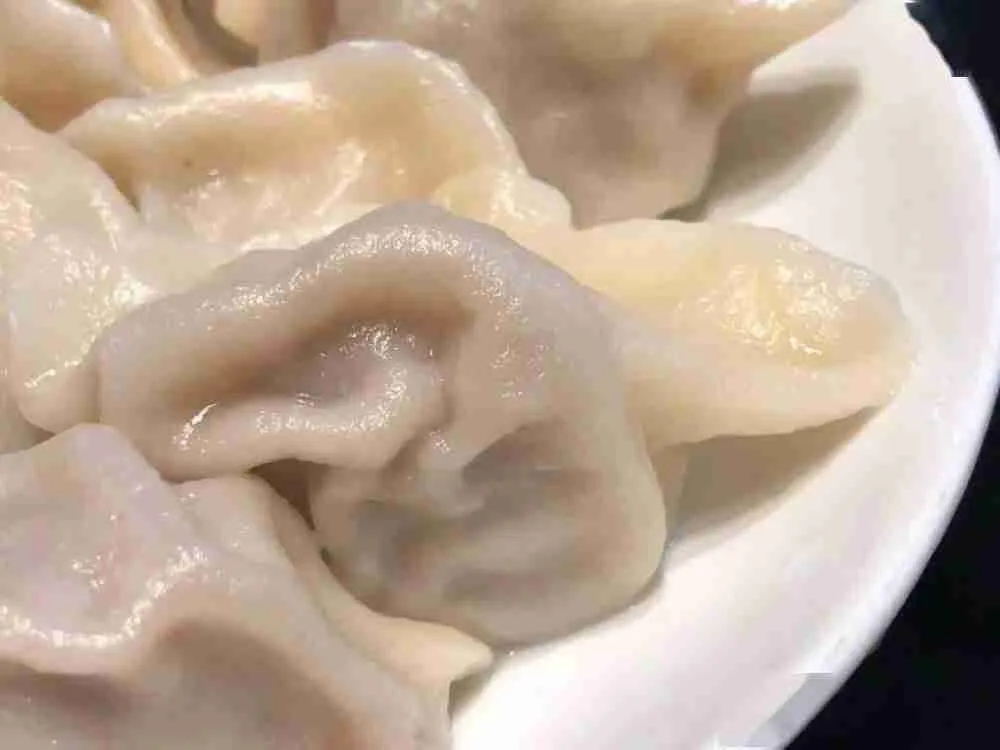
As mentioned, dumplings are a common food that the Chinese love it. It wouldn’t be surprising if they ate them for breakfast, lunch, and dinner. The real question is why do they love dumplings so much? Why are dumplings so important in their culture? Aside from the fact that they are delicious, dumplings have a strong symbolism in Chinese culture.
To begin with, there is a superstition that some Chinese have about eating dumplings. They believe that by eating them you get a sense of hope, peace, and completeness. The reason is that dumplings are normally shaped like the moon. The moon, in Chinese culture, is normally considered a symbol of brightness and abundance.
What do dumplings symbolize in china? Another reason Chinese love eating dumplings is that traditionally it was seen as eating a meal worth gold. This is because some dumplings resembled the gold and silver ingots, which were the currency in Ancient China. As such, dumplings are seen to symbolize good fortune financially, hence the Chinese eat them with the belief that it will lead them to affluence.
Many Chinese also enjoy eating dumplings because the making process is fun and symbolizes togetherness. In Chinese culture, the concepts of family and togetherness are very important. Although the whole process of preparing them is long, the family can pass the time bonding and reminiscing over shared memories as they cook. Another thing is that dumplings are very filling, hence you can only eat so many alone. Therefore, it is a shared meal that is perfect for bringing families together.
When Do Chinese Eat Dumplings?
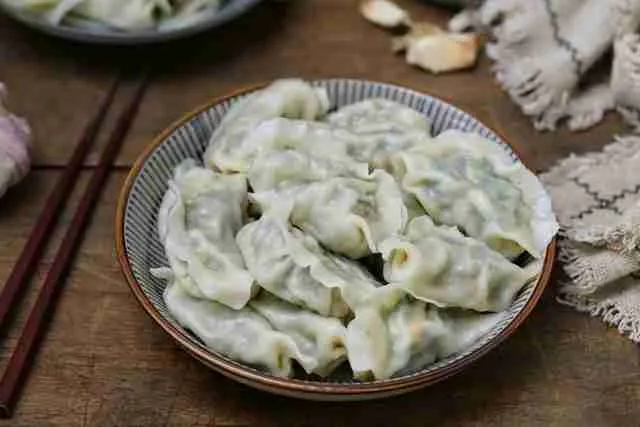
Chinese culture is filled with many symbols. There is always a meaning, behind every color, food, and even festivities. Dumplings are generally a significant traditional food in China, there are, however, specific occasions or festivities where dumplings must be present in the menu. The festivities are as follows:
The Chinese New Year.
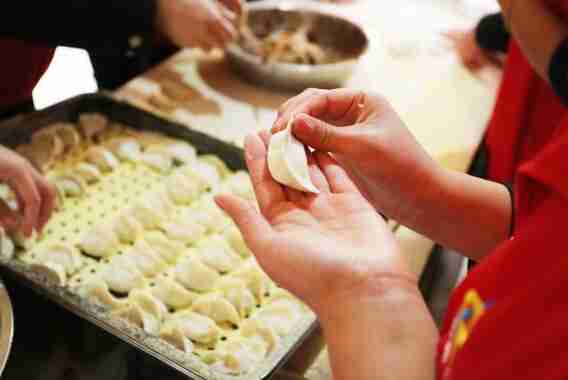
why eat dumplings on chinese new year? Dumplings are considered one of the lucky foods that must be present when celebrating the new year. This is especially true in North China, where dumplings must be eaten on Chinese New Years’ eve during the Spring festival. The reason is that the dumplings are shaped like ingots, the old Chinese currency.
According to ancient Chinese timekeeping, the day was normally divided into 12 two-hour periods. The period between 11 pm and 1 am was called Zi, but during New Year’s Eve, the period had a special name Jiaozi, which sounds similar to the Chinese term for dumplings. As such, every Chinese New Year’s Eve, the families come together in the evening to make the dumplings so they can eat them during jiaozi (11 pm-1 am).
It was believed that by eating the dumplings at this time as they ushered in the new year, the family would experience a lucky new year. Some families would create a game out of it, where they would hide a coin in one of the dumplings. The person who happened to find the gold coin was believed to be lucky that new year.
The fifth day of the First Month According to the Lunar Calendar.
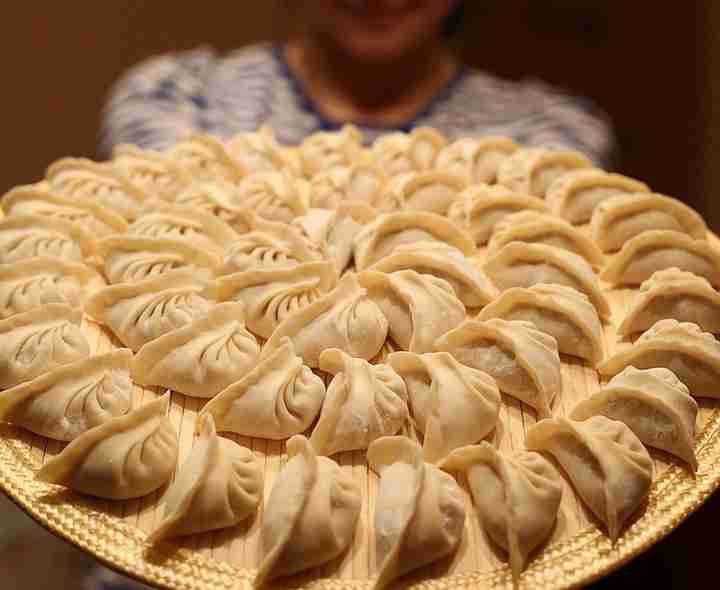
Five days after the New years there is a custom known as “breaking the fifth” that is usually performed. The reason for this custom is that, before the fifth, during the Spring festival, there are a lot of taboos people are meant to avoid. After the fifth day of the month, however, these taboos no longer apply. Therefore, people celebrate by eating dumplings.
On top of this, there some areas where a special custom exists regarding dumplings on this day. It is believed that while preparing the dumplings, you should press the edges of the wrap tightly. This ensures that the people who discuss you in your absence won’t be able to do so in the coming year.
The Beginning of Fu Days.

Fu days can also be referred to as the dog days of summer in China. According to the traditional Chinese calendar, they are 30-40 days between the ‘little heat’ and ‘great heat’ seasons. The first Fu day is another time when people usually eat the dumpling.
The reason behind it is that during the hottest days of the year, people normally end up lacking the appetite to eat. As such, people ate delicious food at the beginning to stimulate their appetite. Dumplings were chosen as the food to be eaten at the time, not only because they were delicious but also because they were filling.
Beginning of Autumn.
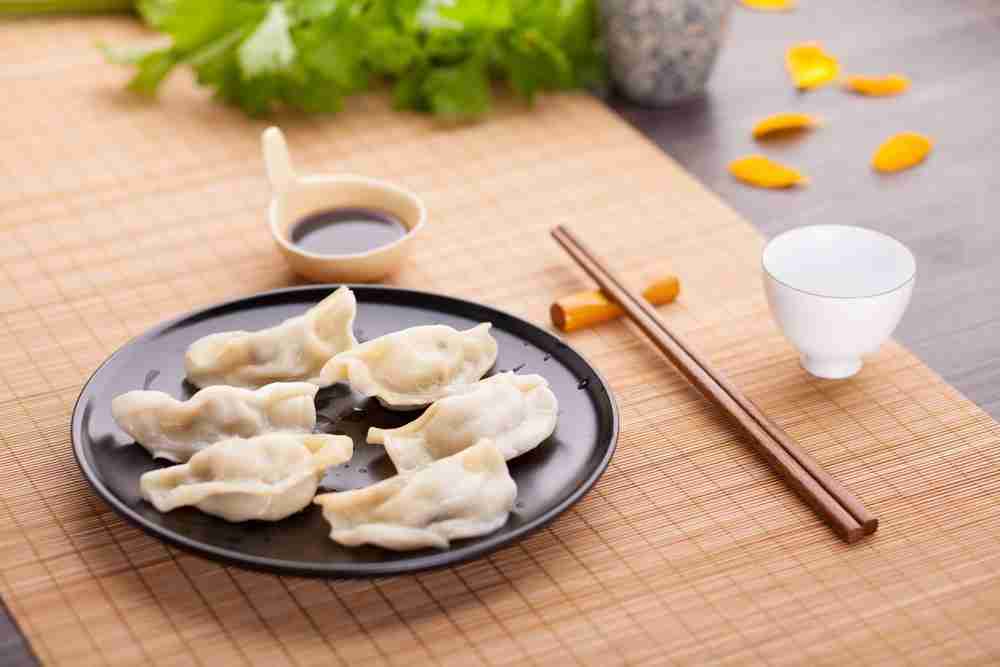
After the extremely hot period in summer, the coolness of autumn is highly appreciated. During the first day of autumn, the Chinese believe that one should eat a good meal, preferably with meat. They do this to gain the weight they believe was lost during the hot summer period and in preparation for the coming winter. For that reason, most people celebrate the beginning of autumn by eating dumplings filled with meat, because they are filling.
Beginning of Winter.
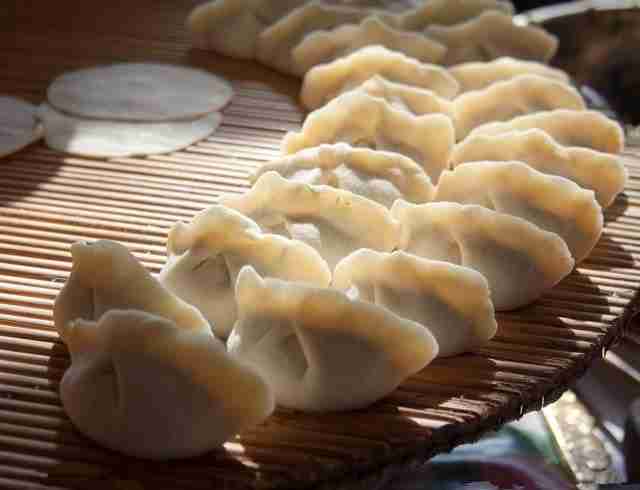
The origin of dumplings is said to be in Winter due to a well-known Chinese folk story about a famous doctor called Zhang Zhongjing. It is said that on one winter’s day, the doctor came across a poor family on his way home. The family didn’t have warm clothes or enough food and as a result, had frost-bitten ears. To try and cure them, Zhang made dumplings with stewed lamb, pepper, and medicine, and fed them to the patients every day. By the time the spring festival started, the patients were completely cured.
As a form of gratitude to Zhang, people continued to make and eat his dumplings to this present day. They are especially eaten at the beginning of winter because people believe that it will keep them healthy enough to survive the cold winter.
Winter Solstice.
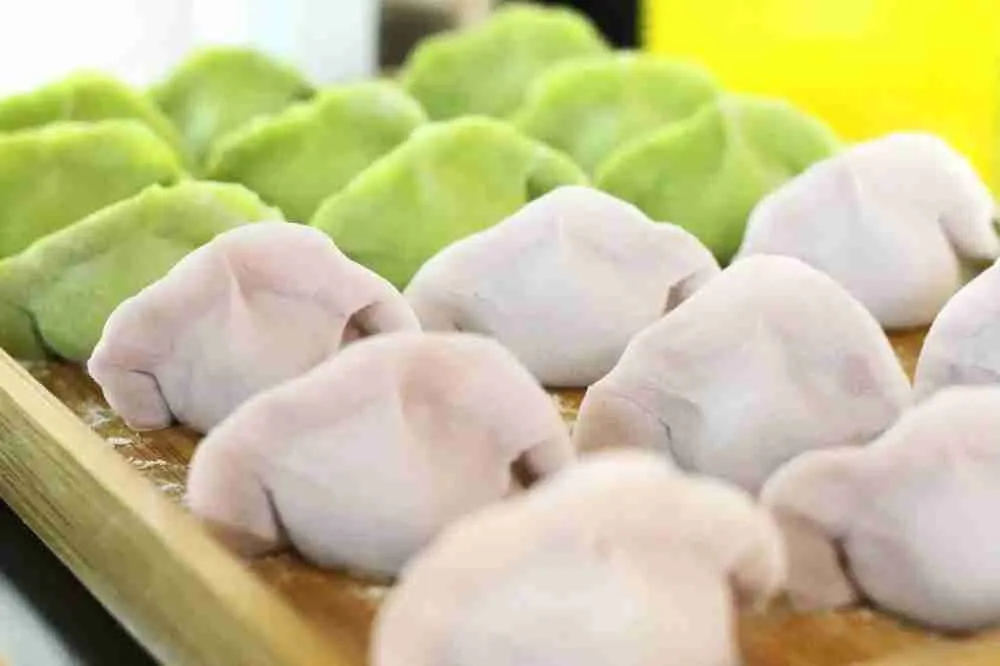
The Winter solstice is the coldest time in winter and a very important period. It is a time when the Chinese families come together to pay respect to their ancestors and eat dumplings. Some believe that the dumplings are made and eaten on this day in commemoration of doctor Zhang’s great deeds. Other’s believe that is in commemoration of the goddess Nua from the Chinese legends.
Nua was said to have created humans, sculpting each one from yellow clay. As she was forming the ears, she was worried that the clay would freeze and the ears would fall off when it became cold. So, she pierced holes into the ears and firmly attached them to the head with a string. People, therefore, eat ear-shaped dumplings during the Winter solstice in commemoration of Nua. Also, because of the superstition that if one doesn’t eat the dumplings on this day, the ears will fall off.
How Many Types Of Chinese Dumplings Are There?-7 Types Of Chinese Dumplings.
As we mentioned earlier, dumplings vary based on their contents and preparations. They also vary based on how they are shaped, with different preferred ways of eating them. The following are some of the most common dumplings you are likely to come across:
Wonton
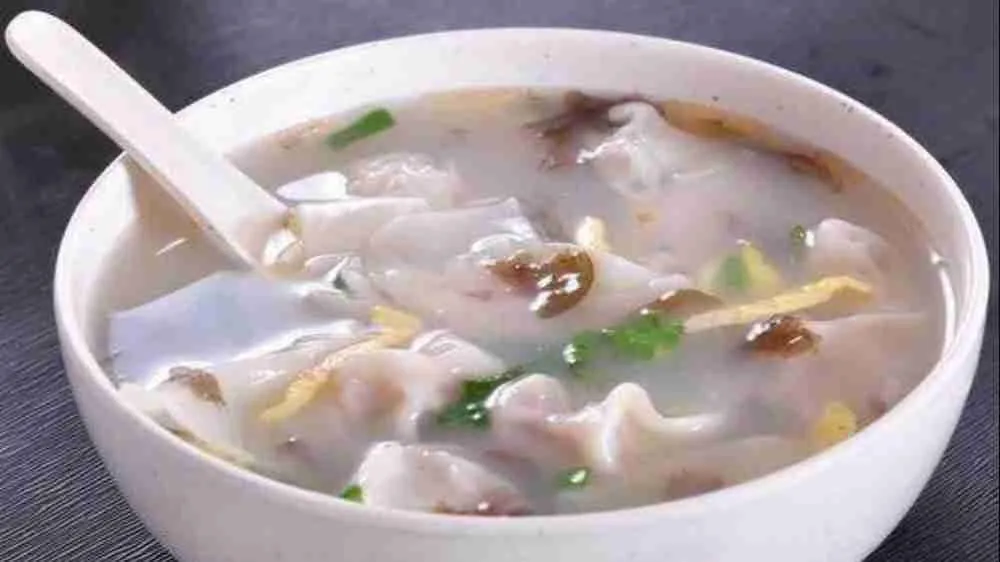
These are perhaps the most common types of dumplings known around the world. They are commonly served in the infamous Wonton soup. They can also be served with chili oil or clear broth. You can fill wontons with whatever you prefer, but they are typically filled with pork or prawn, or shrimp (whole or grounded).
Xiao Long Bao
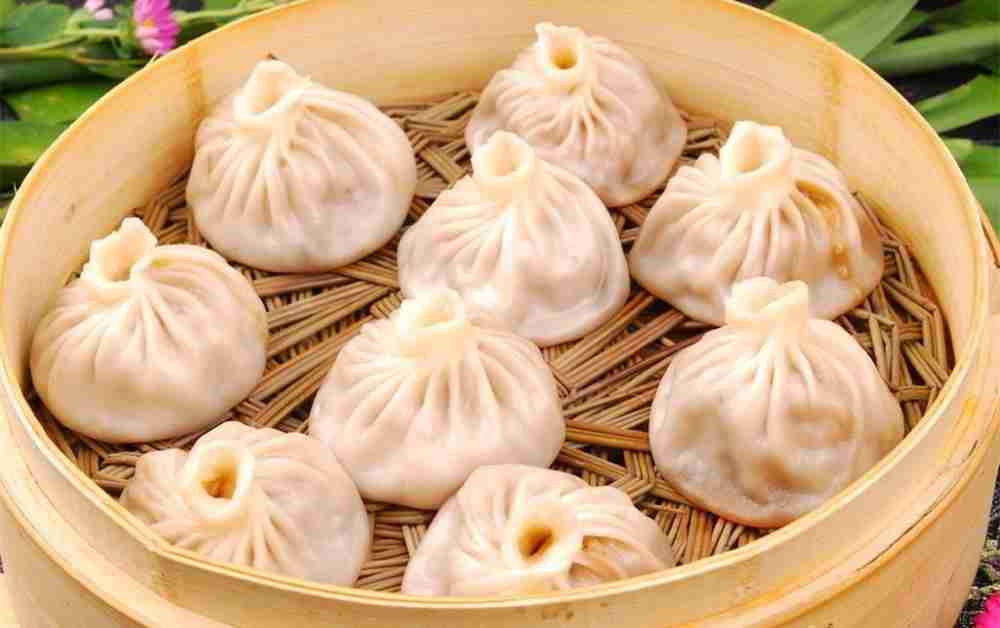
These are perfectly sculpted to keep the contents inside. They are normally steamed and filled with pork and soup. Sheng Jian Bao is a pan-fried variety of Xia long bao with pork, shrimp, and cabbage fillings.
Gyoza.
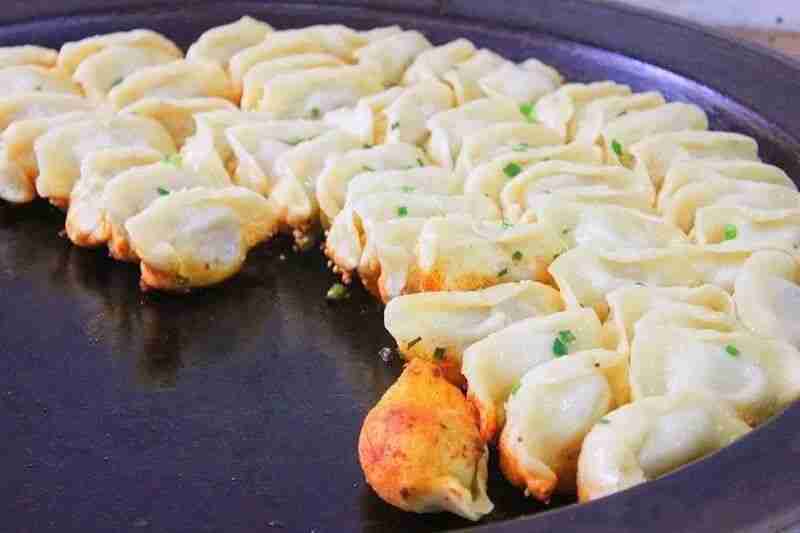
Sometimes referred to as potstickers, these types of dumplings are pan-fried. They are primarily filled with seafood or pork and go great with soy sauce.
Banh Bot Loc.
These types of dumplings are made from tapioca wrappers filled with pork belly and shrimp. They are normally served with sweet fish chili sauce for the best taste. They are considered to be the best appetizers for any meal.
Guo Tie
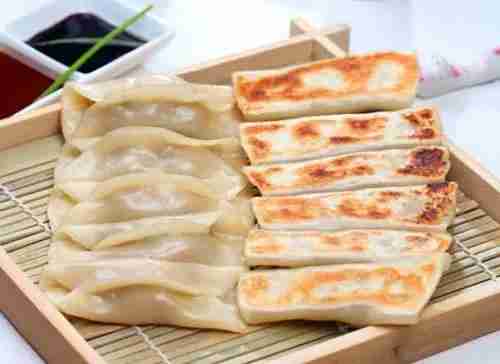
These are other types of pan-fried dumplings that are referred to as potstickers in some restaurants. They are usually filled with ground meat and vegetables and served with soy sauce. They make great appetizers or snacks.
Shui Jiao
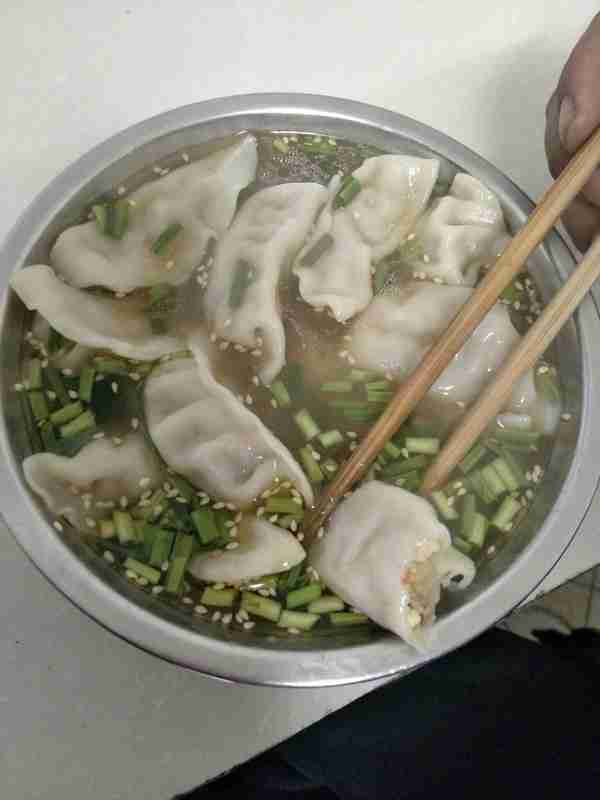
These are traditional-styled dumplings common around Asia. They are water boiled and can e filled with anything you want. It can vary from meat to vegetable or even cheese.
Mandu.
These types of dumplings can be made in a variety of ways. You can boil, steam, or fry them (pan or oil). They are normally filled with ground beef or pork and served with Kimchi on the side.
history of dumplings
There are different theories regarding the origin of dumplings. Some believe that dumplings evolved from “Hun Tun,” while others trace their roots back to the ancient “Jiaozi.” In ancient times, both Hun Tun and dumplings referred to a type of food. Hun Tun appeared early on and resembled the concept of “chaos” mentioned in the philosophical work “Zhuangzi,” hence its name. For a significant period, there was no strict differentiation between dumplings and Hun Tun. During the Northern Qi Dynasty, Yan Zhitui stated, “Nowadays, Hun Tun is crescent-shaped, and it is widely consumed throughout the country.” This indicates that even though they were called Hun Tun, the modern concept of “dumplings” had already formed and gained popularity. From a folk perspective, in times of material scarcity, dumplings were a rare delicacy.
Dumplings are the most popular New Year food in northern China. It is an ancient tradition passed down through generations. Due to geographical and climatic reasons, the northern regions experience a harsh winter during the New Year period, with vast white snow-covered landscapes. Crop cultivation is limited during this time, resulting in a scarcity of ingredients. Hence, dumplings became a preferred choice for the New Year feast. In ancient times, meat was scarce, and dumplings filled with meat were considered a premium food. The folk saying “Nothing is more delicious than dumplings” expresses this sentiment. In the Song Dynasty, dumplings were referred to as “Jiaozi” or “Shui Jiao’er.” During the Yuan Dynasty, the term “Bian Shi” was used, and since the Ming and Qing Dynasties, the term “Jiaozi” has been commonly used.
Development:
● Late Han Dynasty and Three Kingdoms Period:
During the late Han Dynasty and the Three Kingdoms Period, dumplings had already become a type of food known as “Yueya Hun Tun” or “Crescent-shaped Hun Tun.” The book “Guangya” written by Zhang Yi of the Wei Dynasty mentions this food. According to the records in “Guangya,” during the Three Kingdoms Period, there were already food items shaped like crescent moons called “Hun Tun,” which were similar in shape to dumplings.
● Southern and Northern Dynasties:
During the Southern and Northern Dynasties, it was said that Hun Tun was “crescent-shaped and widely consumed throughout the country.” It is speculated that during that time, dumplings were not eaten separately but were cooked and served in a bowl mixed with soup. That’s why people referred to them as “Hun Tun.” This eating style still prevails in some regions of China. For example, in Shaanxi, when eating dumplings, it is common to add cilantro, scallions, dried shrimp, and chives as condiments in the soup.
● Tang Dynasty:
By the Tang Dynasty, dumplings had become almost identical to the modern ones and were eaten individually after being cooked. They were also called “Yan Yue Xing Hun Tun” or “Crescent-shaped Hun Tun.” In the book “Dreams of the Eastern Capital” by Meng Yuanlao, which reminisces about the flourishing city of Bianjing during the Northern Song Dynasty, dumplings were referred to as “Jiao Zi,” “Crystal Jiao Zi,” “Pan-fried Jiao Zi,” “Camel Hump Jiao Zi,” and so on. Although dumplings existed in the Tang Dynasty, an investigation shows that many Tang poets such as Meng Haoran, Li Bai, Du Fu, Wang Wei, Han Yu, and Bai Juyi did not use the term “dumplings” in their works. There are two possible reasons for this. Firstly, the name “dumplings” might have been a colloquial term that did not fit the poetic rhythm and context. Secondly, the regional nature of food might have played a role.
● Song Dynasty:
During the Song Dynasty, dumplings were called “Jiao Er,” which is the etymology of the later term “Jiao Zi” for dumplings. In the book “Dreams of the Eastern Capital” by Meng Yuanlao, which reminisces about the prosperous Bianjing city in the Northern Song Dynasty, it is mentioned that there were “Crystal Jiao Zi,” “Pan-fried Jiao Zi,” and “Various-colored Jiao Zi” in the market. The same writing style can be seen in later periods, including the Yuan, Ming, Qing, and Republic of China eras. During the Southern Song Dynasty, they were called “Zao Rou Shuang Xia Jiao Zi” or “Dumplings with Dried Meat.”
Dumplings were introduced to Mongolia during the Song Dynasty. In the Mongolian language, the pronunciation of dumplings was similar to “Bian Shi.” With the Mongol Empire’s conquests, dumplings, known as “Bian Shi,” spread to various parts of the world, giving rise to different variations like Russian dumplings, Kazakh dumplings, and more.
● Ming Dynasty:
According to historical records, the custom of eating dumplings during the Spring Festival (Chinese New Year) appeared at the latest during the Ming Dynasty. The book “Zhuo Zhong Zhi” states that during the Ming Dynasty, the palace would rise at five in the morning on the first day of the lunar year, drink pepper wine, and eat water snacks (dumplings). Some dumplings would secretly contain silver coins, and those who found them would divine good fortune for the coming year. This day was also a time for mutual greetings and blessings, known as “celebrating the new year.”
● Qing Dynasty:
Historical records from the Qing Dynasty state, “On New Year’s Day at midnight, various delicacies were served, such as Bian Shi (another name for dumplings).” It is also mentioned, “On the first day of the year, regardless of wealth or status, everyone made dumplings with white flour. It was called ‘Zhuo Bao Bao.’ The entire country followed this tradition, without exception. In wealthy households, gold and silver small ingots were hidden in the dumplings to divine good luck. Those eaten by family members would have great fortune throughout the year.” This indicates that during the Spring Festival, regardless of wealth, every household would eat dumplings, symbolizing auspiciousness and bidding farewell to the old while welcoming the new. In “Qing Bai Lei Chao” compiled by Xu Ke, it is mentioned, “Some dumplings have fillings, also known as ‘Fen Jiao.’ They can be steamed or pan-fried. Boiling them in water produces water dumplings.” “During the first month, from the first to the fifth day, people traditionally eat water dumplings.”
who invented Chinese dumplings?
During his tenure as an official in Changsha, Zhang Zhongjing witnessed the plight of homeless people suffering from the bitter cold and snow by the banks of Baihe River. Moved by their suffering, he developed a therapeutic recipe called “Quchan Jiao’er Tang” or “Cold-Dispelling Dumpling Ear Soup” to provide relief. Zhang Zhongjing’s reputation had spread far and wide, and many people sought his medical assistance. Despite the high demand, he remained concerned about those with frostbitten ears.
After conducting research, Zhang Zhongjing created a food therapy recipe that could ward off the cold. He instructed his disciples to set up a shelter in an open space at the eastern gate of Nanyang. They erected a large pot and offered free treatment and medicine to the poor. This opening day coincided with the Winter Solstice, and the medicine offered was the “Quchan Jiao’er Tang.”
The original Quchan Jiao’er Tang involved boiling lamb meat and certain herbs in a pot. Once cooked, the meat was diced and wrapped in dough shaped like ears. These dumplings were then boiled in the original broth until the dough was cooked. The dumplings resembled ears, and their purpose was to prevent frostbite, hence the name “Jiao’er” (ears) given by Zhang Zhongjing.
Zhang Zhongjing instructed his disciples to serve each poor person a bowl of soup and two “Jiao’er” dumplings. Upon eating the dumplings and drinking the soup, people felt warm throughout their bodies, and their previously frostbitten ears regained warmth. No one suffered from frozen ears again. During his tenure in Changsha, Zhang Zhongjing frequently treated common people, earning their love and respect. After his retirement, representatives from Changsha would visit his hometown every year to pay their respects.
As the saying goes, “Physicians find it difficult to treat themselves.” Zhang Zhongjing was human, not divine. In one year, he fell ill and realized that his life’s flame was about to extinguish. People who came to visit him in Changsha suggested that it was an auspicious place for him to spend his remaining days. However, the people from Nanyang objected, leading to a heated argument. Zhang Zhongjing said, “Having consumed the water of Changsha, I cannot forget the kindness of its people. Born on the land of Nanyang, I cannot forget my hometown’s nurturing grace. After my death, carry my coffin from Nanyang to Changsha. Wherever the spirit rope breaks, bury me there.”
On that winter day, Zhang Zhongjing departed from this world. It happened to be the Winter Solstice. When the funeral procession reached the site where Zhang Zhongjing had once offered the “Quchan Jiao’er Tang” to everyone, the coffin rope suddenly broke. Following Zhang Zhongjing’s instructions, the local people immediately dug a grave, placed the coffin, and filled the burial mound. People from both places worked together to transport his remains, making the tomb monument significant. They also built a temple in front of the tomb, which is now known as the Temple of the Medical Saint.
Zhang Zhongjing passed away on the Winter Solstice, the same day he had offered the “Quchan Jiao’er Tang” to others. In commemoration of him, people started the tradition of making and eating dumplings on the Winter Solstice. It is believed that eating dumplings on this day prevents freezing of the ears during winter.
While the consumption of the “Quchan Jiao’er Tang” declined over time, the custom of eating dumplings on the Winter Solstice has endured. The varieties and shapes of dumplings have evolved significantly, and dumplings have become a symbolic food representing family reunion in Chinese culture. However, Zhang Zhongjing’s name is rarely mentioned nowadays.
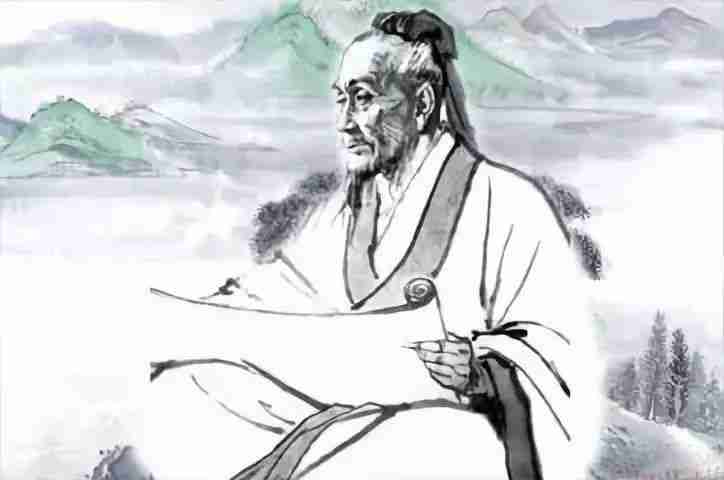
when were Chinese dumplings invented?
Dumplings were invented during the Eastern Han Dynasty. Throughout their long history, dumplings have had various names. In ancient times, they were called “Laowan,” “Bianshi,” “Jiao’er,” “Fenjiao,” and so on. During the Three Kingdoms period, they were known as “Yuanyue Huntun,” during the Northern and Southern Dynasties as “Huntun,” during the Tang Dynasty as “Yan Yue Xing Huntun,” during the Song Dynasty as “Jiaozi,” and during the Yuan Dynasty as “Bianshi.” In the Qing Dynasty, they came to be known as “Jiaozi.”
The origin of dumplings can be traced back to the Eastern Han Dynasty when Zhang Zhongjing, a renowned physician from Nanyang, invented them. Originally, dumplings were used for medicinal purposes. Zhang Zhongjing wrapped dough around herbs with warming properties, such as lamb meat and pepper, to treat patients and prevent frostbite on their ears.
The original name for dumplings was “Jiao’er,” and it is believed to have been first created by Zhang Zhongjing, the Medical Saint of China. The story of his “Quchan Jiao’er Tang” has been passed down through generations. There is a popular saying that goes, “Nothing tastes better than dumplings.” Zhang Zhongjing’s medicinal recipe was called “Quchan Jiao’er Tang” and was developed based on over 300 years of clinical practice during the Han Dynasty. The process involved boiling lamb meat and certain herbs in a pot. Once cooked, the ingredients were diced and wrapped in dough to resemble ears, hence the name “Jiao’er” (ears). These dumplings were then boiled and served to patients seeking treatment. Each person received two “Jiao’er” dumplings and a bowl of soup. After consuming the warming soup, people would feel a warm sensation throughout their bodies, improved blood circulation, and warmer ears. From the Winter Solstice to the Lunar New Year’s Eve, people would eat dumplings, effectively warding off cold-related illnesses and preventing frostbitten ears.
why were dumplings invented?
Dumplings, a traditional Chinese food, originated from the ancient “Jiaozi.” Originally known as “Jiao’er,” dumplings were first invented by Zhang Zhongjing, a Medical Saint from Dengzhou, China, over 1,800 years ago. They are a beloved traditional specialty food deeply cherished by the Chinese people. Dumplings, also known as boiled dumplings or water dumplings, are a staple food and local snack in China, as well as a festive dish during holidays. There is a folk rhyme that says, “Dahan, Xiaohan, eat dumplings for the Lunar New Year.”
Dumplings are typically made by wrapping fillings in dough and boiling them in water. The origin of dumplings can be traced back to the Eastern Han Dynasty, where Zhang Zhongjing, a native of Nanyang in Henan Province, known as the “Medical Saint,” first created them. At that time, dumplings were used for medicinal purposes, with Zhang Zhongjing using dough to wrap herbs with warming properties (such as lamb meat and pepper) to treat diseases and prevent frostbite on patients’ ears.
Dumplings evolved from “Huntun,” and throughout their long development, they had various names. In ancient times, they were referred to as “Laowan,” “Bianshi,” “Jiaodie,” “Fenjiao,” and more. During the Three Kingdoms period, they were called “Yuanyue Huntun,” during the Northern and Southern Dynasties as “Huntun,” during the Tang Dynasty as “Yan Yue Xing Huntun,” during the Song Dynasty as “Jiaozi,” and during the Yuan Dynasty as “Bianshi.” In the Qing Dynasty, they came to be known as “Jiaozi.”
Dumplings have a rich history as a popular folk cuisine cherished by the common people. Eating dumplings during the Spring Festival symbolizes bidding farewell to the old year and welcoming the new. It is a unique cultural tradition for the Chinese people during the Lunar New Year.
where dumplings originated from?
Dumplings officially appeared on the stage of history thanks to Zhang Zhongjing, the Medical Saint from Nanyang (present-day Dengzhou) in the Eastern Han Dynasty. During that time, dumplings were accidentally invented by Zhang Zhongjing, and their original purpose was not as food but as medicine.
Legend has it that during the late Eastern Han Dynasty, the country was plagued by an epidemic, and the weather was extremely cold. Many people were infected with diseases, and their ears suffered from frostbite due to the severe cold. In order to alleviate this condition, Zhang Zhongjing kneaded dough into a folded shape and boiled it in a pot. He added many herbs with warming properties to the pot, and this medicinal concoction was named “Qu Han Jiao Er Tang.” The dough inside was called “Jiao Er,” with the hope of restoring the frozen ears to their original state.
Zhang Zhongjing continued to administer this medicine until the Lunar New Year. In gratitude, people imitated the “Jiao Er” by boiling dough without the filling. Although the taste of these early dumplings was not delicious and they were primarily used for medicinal purposes, they laid the foundation for the development of dumplings in the future.
dumplings story
In order to commemorate Pangu’s creation of the world and the end of chaos, and to symbolize abundance of food, the name “dumpling” was chosen, as it sounds similar to the word “hun dun,” meaning “filled with food.” Additionally, there is a folk belief associated with eating dumplings and the story of Nüwa, the goddess who created humans. When Nüwa molded humans from clay, the earth was cold and frozen, making it easy for the earthen humans’ ears to freeze off. To prevent this, Nüwa pierced a small hole in the ears and tied them with a thin thread, with the other end of the thread placed in the mouth of the earthen human to hold it in place. In order to commemorate Nüwa’s achievement, people started making dumplings shaped like human ears, with filling (representing the thread), and biting into them with their mouths.

what are Chinese dumplings used for?
Dumplings originated from an ancient dish called “Jiaozi,” also known as “Jiao Er,” “Jiao Er Tang,” “Gu Zha,” and “Zi Sun Bo Bo.” It is believed that dumplings were invented by Zhang Zhongjing, the Medical Saint of ancient China.
Zhang Zhongjing was always concerned about the poor villagers with frostbitten ears. When the Winter Solstice arrived, he set up a medical tent and provided treatment for frostbite to the impoverished. He cooked lamb, chili, and warming herbs in a pot, and when the concoction reached the right temperature, he removed the lamb and herbs, chopped them into pieces, and wrapped them in dough shaped like ears. This medicinal dish was called “Qu Han Jiao Er Tang.”
He distributed this medicinal soup to the villagers, giving each person a large bowl of soup and two “Jiao Er” dumplings. After consuming the soup and dumplings, they felt warm throughout their bodies, and their ears became heated. Zhang Zhongjing continued his medical treatments until New Year’s Eve, and the villagers celebrated a joyous and healthy new year with their healed ears.
Since then, every Winter Solstice, people recalled the scenes of Dr. Zhang’s treatment and started imitating the method of making “Jiao Er” as food. To differentiate from the medicinal “Jiao Er Tang,” they changed the name to “Jiao Er.” As the name changed over time, people began calling them “dumplings.” Gradually, the tradition of eating dumplings on the Winter Solstice became established.
Dumplings are a staple and local delicacy in northern China. People often say, “Nothing tastes better than dumplings,” which reflects their deep affection for this dish. Making dumplings on New Year’s Eve is an important tradition in northern China. There is a folk rhyme that goes, “During the extreme and lesser cold, we eat dumplings for the New Year.” During the New Year, it is not only about making dumplings but also about eating them.
There is a saying, “On New Year’s Eve, we eat dumplings — no outsiders.” The dumplings for the New Year’s Eve dinner symbolize family reunion. They are traditionally eaten on New Year’s Eve, symbolizing family unity and the arrival of a new year.
On New Year’s Eve, as firecrackers sound to bid farewell to the old and welcome the new, dumplings are dropped into boiling water and cooked. After being cooked, they are first offered to the deities and ancestors before being enjoyed alongside other dishes.
This tradition is related to ancient Chinese timekeeping methods. Ancient China used the twelve Earthly Branches to record each day. Each day was divided into twelve time periods, with the day starting at midnight, known as “Zi Shi.” On New Year’s Eve, the transition from the old to the new year occurs, which the Chinese call “Jiao Zi.”
Chinese people place great importance on boundaries, especially the boundary between bidding farewell to the old and welcoming the new. Thus, during this time, ceremonies are held to pray for good fortune in the coming year. The word “Jiao Zi” sounds similar to “Jiao Zi” (dumplings), and the custom of eating dumplings at the moment of “Jiao Zi” on the first day of the lunar year satisfies this need.
Dumplings resemble ancient Chinese gold ingots, and eating them during the Spring Festival symbolizes attracting wealth and prosperity. Additionally, the fillings in dumplings allow people to include various auspicious ingredients, expressing their hopes for the new year. When making dumplings, people often include items such as golden ingots, sugar, peanuts, dates, and chestnuts in the filling, symbolizing positive wishes. Those who eat the “golden ingot” dumplings or those with sugar will have a sweeter year ahead. Those who eat dumplings with peanuts will have good health and longevity, while those who eat dumplings with dates and chestnuts will have an early birth of noble children.
what does dumplings symbolize?
In addition to its delicious taste, dumplings have the following unique and auspicious meanings:
Wealth and Good Fortune: The shape of dumplings resembles gold ingots, so eating dumplings symbolizes the attraction of wealth and prosperity. Furthermore, the word for “dumpling” sounds similar to “Jiao Zi,” which in the Song Dynasty referred to silver notes or banknotes, representing wealth. Therefore, eating dumplings during festivals, especially during the Spring Festival, is often associated with the meaning and symbol of acquiring wealth and good fortune. In some cases, people even put a coin inside one dumpling in a pot, and the person who finds it in their serving is believed to have abundant financial luck, expressing blessings for a prosperous life for their family.
Reunion and Harmony: Dumplings also represent the idea of reunion and harmony. When family members gather, it is common to eat dumplings, which enhances the atmosphere of togetherness and creates cherished memories. The process of making dumplings together involves laughter, conversation, and a joyful atmosphere, fostering a sense of unity and contentment. Therefore, people often eat dumplings during family reunions, such as during the Spring Festival, Winter Solstice, and Lantern Festival, as it is considered a warm and auspicious activity.
Peace and Good Wishes: Eating dumplings often carries the meaning of praying for blessings. In busy daily life, it is difficult for family members to gather and find leisure time to make dumplings together. However, during special occasions like the Lunar New Year or family reunions, there is a desire for the well-being and prosperity of the entire family. Making and eating dumplings together becomes the best way to express these wishes. Dumplings acquire a unique significance, representing the prayer for the safety and well-being of family members, hoping for smooth and successful lives, abundant harvests, prosperity, and good fortune. Therefore, eating dumplings also symbolizes peace and good wishes.
why do dumplings symbolize wealth?
Dumplings are similar to gold ingots, so people hope that eating dumplings can bring wealth and prosperity. They also symbolize joy and reunion, representing the anticipation of good luck in the new year. With fillings inside the dumplings, people will wrap auspicious and lucky symbols within the dumpling fillings, expressing their hopes for the upcoming year. The significance of eating dumplings during the Lunar New Year is “Geng Sui Jiao Zi,” where “Zi” refers to the midnight hour. The words “Shi,” “Jiao,” and “Jiao” sound similar, conveying the meanings of “celebration,” “auspiciousness,” and “happiness” as well as “happiness, auspiciousness, and reunion.”
style Chinese dumplings symbolism
Chinese people have diverse preferences in food, with rice being the staple for people in the south and noodles being the main choice for those in the north. Dumplings, however, are a beloved dish among people in the northern regions. Dumplings in China are not only a delicious food but also embody Chinese cultural elements. They are a common snack in everyday life and an essential food for the evening of Chinese New Year, expressing people’s longing for a better life.
Cultural Significance of Dumpling Fillings:
Celery Filling – Signifies diligence in wealth accumulation, hence known as “Diligent Wealth Dumplings.”
“Diligent” refers to hard work and diligence, frequently and continuously generating wealth, hence the name “Diligent Wealth.” It is a blessing for a steady flow of material wealth and also a wish for diligence and practicality.
Chinese Chives Filling – Signifies long-term wealth, hence known as “Long-term Wealth Dumplings.”
“Long-term” refers to a long duration, signifying long-lasting wealth. It represents a wish for enduring material prosperity and also a wish for everlasting happiness, health, harmony, and well-being.
Chinese Cabbage Filling – Signifies abundant wealth, hence known as “Abundant Wealth Dumplings.”
“Hundred” is a measure word that represents a variety of things. “Hundred Wealth” signifies a blessing for diverse forms of wealth or a wish for a happy and long-lasting marriage.
Shiitake Mushroom Filling – Signifies booming wealth, hence known as “Booming Wealth Dumplings.”
“Booming” refers to a prosperous rise or growth. The shape of shiitake mushrooms resembles an upward arrow or the upward trend of the stock market. It conveys the meaning of wealth booming upward and can also be a blessing for younger generations to achieve success.
Sauerkraut Filling – Signifies calculated wealth, hence known as “Calculated Wealth Dumplings.”
“Calculated” refers to planning and accounting. If one has so much money that it requires calculation throughout the night, it represents calculated wealth. It can also be a blessing for making good choices, wishing that friends and relatives make wise decisions and have a good outcome.
Canola (Rapeseed) Filling – Signifies possessing wealth, hence known as “Wealthy Dumplings.”
“Having” refers to existence. Those familiar with Zhao Benshan’s comedy sketches won’t forget the famous quote, “You have talent, so much talent.” It signifies possessing wealth and talent. It wishes for both wealth and talent.
Fish Filling – Signifies surplus wealth, hence known as “Surplus Wealth Dumplings.”
“Surplus” refers to what is left over or in excess. It represents a wish for surplus wealth year after year, signifying the leftovers of hard work as wealth and good health.
Beef Filling – Signifies bullish wealth, hence known as “Bullish Wealth Dumplings.”
“Bullish” refers to a strong and rising trend. It is a favorite saying among stock traders during a bull market. It signifies bullish wealth and also wishes for good health and a strong spirit.
Lamb Filling – Signifies foreign wealth, hence known as “Foreign Wealth Dumplings.”
“Foreign” refers to vastness and multitude, even broader than the sea. It wishes for abundant wealth, signifying foreign wealth.
Red Date Filling – Signifies attracting wealth, hence known as “Wealth-Attracting Dumplings.”
“Attracting” refers to calling or summoning, like a wealth god who controls all wealth in the world. It signifies attracting wealth. Traditionally, people liked to put coins inside dumplings, and the person who finds the coin is believed to have the best luck. However, for safety and hygiene reasons, red dates are now used instead, symbolizing a wish for a prosperous and auspicious year.
Wild Vegetable Filling – Signifies unexpected wealth, hence known as “Unexpected Wealth Dumplings.”
“Wild” refers to the outdoors or unexpected situations. Who wouldn’t like unexpected, green, and healthy wealth? It signifies unexpected wealth.
Vegetable Filling – Signifies arriving wealth, hence known as “Arriving Wealth Dumplings.”
“Arriving Wealth” signifies the arrival of wealth or the arrival of the wealth god. It conveys the meaning of welcoming and receiving wealth and abundance.
Sweet Filling – Signifies increasing wealth, hence known as “Increasing Wealth Dumplings.”
“Increasing Wealth” refers to adding or increasing wealth. It can refer to sweet desserts like tangyuan or mooncakes. It also sounds similar to the word “genius,” signifying the increase of wealth.
When making dumplings, people often wrap items like a golden ingot, brown sugar, peanuts, dates, chestnuts, and even coins into the fillings. Those who eat the ingot or brown sugar symbolize a sweeter year ahead, while those who consume peanuts wish for health and longevity. Eating dates and chestnuts signifies the hope for early marriage and having children, while consuming coins represents continuous wealth.
what do dumplings represent in Chinese new year?
The significance of eating dumplings during Chinese New Year is known as “Geng Sui Jiao Zi.” The word “Zi” represents the midnight hour, and “Jiao” sounds similar to “交” (Jiao), which means “exchange” or “togetherness.” Therefore, eating dumplings during Chinese New Year signifies the joyous and auspicious celebration of happiness and family reunion. Eating dumplings during the New Year symbolizes good fortune, bidding farewell to the old year and welcoming the new one. Making dumplings also represents joy, auspiciousness, and happiness.
Homophonic “Jiao Zi”:
The word “Jiao Zi” sounds similar to “交子” (Jiao Zi), and the Chinese New Year’s Eve is also called “Chu Xi,” representing the transition from the old year to the new year. It is the hour of “Jiao Zi,” so eating dumplings during the Chinese New Year carries the meaning of bidding farewell to the old and welcoming the new. Therefore, eating dumplings is a must for Chinese people during the New Year.
Abundance of Wealth:
In ancient times, money was represented by ingots, which have a shape similar to dumplings with a rounded middle and two tapered ends. Therefore, eating dumplings during the New Year can be seen as symbolically consuming ingots, signifying a prosperous and abundant year ahead. It represents good fortune and the more dumplings one eats, the more wealth one may receive in the new year.
Symbol of Peace and Auspiciousness:
During traditional Chinese New Year celebrations, known as the Spring Festival, according to ancient customs, New Year’s Eve is a day when humans, ghosts, and deities engage in a battle. Therefore, everyone must participate to ensure a peaceful and auspicious year ahead. Thus, making and eating dumplings during the New Year serves as a symbolic act of dispelling evil spirits and seeking good luck. Eating dumplings is believed to bring good luck and drive away any negative influences, bringing the most auspicious and joyful fortunes.
Health and Well-being:
There are various legends associated with eating dumplings during the New Year. One legend traces back to the creation of the world by Pangu, while another is related to the creation of humans by the goddess Nüwa. According to the legend, when Nüwa created humans, the weather was extremely cold, causing people’s ears to freeze. Eating dumplings is believed to bring good health and well-being for the coming year, expressing the hope for a healthy and prosperous future.
what type of dumplings are eaten in Chinese new year?
Celery Dumpling: It signifies “Diligent Wealth.” Diligent refers to hardworking, frequent, and continuous efforts. It represents the prayer for a continuous flow of material wealth and blessings for diligence and practicality.
Chive Dumpling: It signifies “Long-lasting Wealth.” Long-lasting refers to a long time and enduring. It represents the prayer for long-lasting material wealth and blessings for longevity, health, harmony, happiness, and well-being.
Cabbage Dumpling: It signifies “Abundant Wealth.” Abundant refers to a large variety or quantity, representing a prayer for abundant wealth or a beautiful wish for a newlywed couple to grow old together.
Mushroom Dumpling: It signifies “Prosperous Wealth.” Prosperous refers to rising and fullness, symbolizing the upward trend of the stock market or mushroom-shaped mushrooms. It represents the prayer for financial prosperity or expresses a hopeful wish for the younger generation to achieve great success.
Sour Cabbage Dumpling: It signifies “Calculative Wealth.” Calculative refers to calculation or settlement. It represents the prayer for good decision-making and the wish for friends and relatives to have good choices and outcomes.
why are dumplings important for Chinese new year?
Dumplings are considered important for Chinese New Year for several reasons:
Symbol of Wealth and Prosperity: Dumplings are shaped like ancient Chinese gold or silver ingots, which were used as currency. Eating dumplings during the New Year is believed to bring wealth and prosperity for the coming year.
Family Reunion: Chinese New Year is a time for family gatherings and celebrations. Making and eating dumplings together is a tradition that promotes family unity and bonding. It is a way for family members to participate in the preparation and enjoy the meal together.
Symbol of Good Luck: Dumplings are often filled with various ingredients, and their shape resembles a traditional Chinese coin. Eating dumplings during Chinese New Year is believed to bring good luck and fortune for the year ahead.
Warding Off Evil Spirits: In ancient Chinese folklore, it was believed that evil spirits were more active during the New Year. The shape of dumplings, similar to ancient Chinese money, was thought to repel these spirits and protect against misfortune.
New Beginnings: Chinese New Year marks the beginning of a new lunar year. Dumplings are seen as a way to bid farewell to the old year and welcome the new one. They symbolize new beginnings, fresh starts, and hopes for a better future.
Overall, dumplings hold cultural significance during Chinese New Year, representing wealth, family unity, good luck, protection, and new beginnings. They are an essential part of the festive celebrations and are enjoyed by people of all ages.
dumplings in Chinese wedding
“Jiéhūn chī jiǎozi” is a Chinese proverb that means “eating dumplings during a wedding ceremony.” It symbolizes the belief that the marriage will be long-lasting and fulfilling.
In Chinese culture, dumplings hold great significance, not only because they taste delicious but also because they symbolize reunion and happiness. It is said that dumplings originated in northern China, where people would wrap fillings in dough and cook them in hot water during the cold winter months to keep warm and satiated. Over time, dumplings became an essential food item for celebrating major festivals and family gatherings in China.
Eating dumplings as part of wedding celebrations is a traditional practice in Chinese wedding culture. In Chinese culture, dumplings symbolize “reunion” and “completeness” due to their round shape. When two people get married, they are like the two ends of a dumpling, stitching their lives together, making their marriage strong and complete.
Apart from the symbolic significance, there are practical aspects to eating dumplings during weddings. During a Chinese wedding, the bride and groom often participate in dumpling-making activities with their families and relatives, which is an important ritual. The process of making dumplings allows for emotional bonding, fostering mutual understanding and trust among family members. Simultaneously, it deepens the intimate relationship between the newlyweds and their families, creating a sense of warmth and love.
There are specific customs associated with eating dumplings during wedding ceremonies. Typically, the newlyweds distribute dumplings to their families and relatives, symbolizing the integration of their own family and lives into another family. Additionally, the bride and groom feed each other dumplings, representing their commitment to spendingtheir lives together, supporting and taking care of each other.
In summary, the proverb “eating dumplings during a wedding ceremony” conveys the auspicious meaning of a happy and harmonious marriage. In traditional Chinese culture, dumplings hold great importance, and there are cultural customs and significances associated with “eating dumplings during a wedding ceremony.”
Dumpling Making
Dumpling making is a significant activity in traditional Chinese culture. During wedding celebrations, the bride and groom typically participate in dumpling making with their families and relatives. The process of making dumplings allows for emotional bonding, deepening understanding and trust among individuals. It also strengthens the intimate relationship between the newlyweds and their families, allowing them to feel the warmth and love of the family.
During the dumpling making process, there is a small game called “hidden filling” or “càng xiàn” in Chinese. The rule of this game is that after everyone wraps the dumplings, one of the dumplings is secretly filled with special ingredients such as chili or sesame. After all the dumplings are cooked, everyone can start eating them. Whoever eats the dumpling with the special filling has to complete a task, such as singing or dancing. This game enhances the festive atmosphere and adds joy to the celebration of the newlyweds.
Dumpling Distribution
Dumpling distribution is also an important ritual in traditional Chinese culture. During wedding celebrations, the bride and groom typically distribute dumplings to their families and relatives, symbolizing the integration of their own family and lives into another family. It also signifies a closer bond between the newlyweds and their families.
During the dumpling distribution, there is a small game called “dumpling grabbing” or “qiǎng jiǎo” in Chinese. The rule of this game is that the bride holds a large bowl filled with dumplings and distributes them one by one to the family members and relatives. Everyone uses chopsticks to grab the dumplings and put them into their mouths. If two people grab the same dumpling at the same time, they compete to see who swallows it first. If the bride grabs the dumpling, it symbolizes that she will have control over the marriage; if the groom grabs the dumpling, it signifies that he will take on more responsibilities in the marriage.
Dumpling Feeding
Dumpling feeding is an important ritual during wedding celebrations. Typically, the bride feeds dumplings to the groom, symbolizing her commitment to taking care of him and wishing him a happy, healthy, and long life.
During the dumpling feeding, there is a small ritual called “garlic pork” or “suàn ní bái ròu” in Chinese. The ritual involves the bride using chopsticks to pick up a piece of garlic pork and placing it in the groom’s bowl. Then, the groom uses chopsticks to pick up the meat and put it into the bride’s bowl. This process symbolizes mutual respect, care, and the shared responsibility and burdens of life between the bride and groom.
Dumpling Eating
Eating dumplings is an important ritual during wedding celebrations. In traditional Chinese culture, dumplings represent reunion and happiness, making eating dumplings a symbol of joy and fulfillment.
During the dumpling eating, there is a small game called “welcoming the God of Wealth” or “jiē cái shén” in Chinese. The game involves hiding a coin inside one of the dumplings and mixing it with the rest. People take turns eating the dumplings, and whoever finds the dumpling with the coin is believed to receive the blessings and good fortune of the God of Wealth. This game adds to the festive atmosphere and makes the special day even more enjoyable.
Etiquette
Apart from eating dumplings, there are many other customs and rules observed during wedding celebrations. For example, before the bride enters her new home, she walks through a decorated threshold symbolizing the crossing of the marriage boundary. After entering the new home, the bride bows to the elders and relatives of the groom’s family as a sign of respect and humility. The bride also serves tea to the groom and his parents, symbolizing her becoming a part of the new family and her commitment to contribute to the family.
In addition to the mentioned customs and rules, there are also some specific regional customs and ceremonies. For example, in some regions, the bride embroiders a new garment with a red thread under the guidance of her parents before the wedding. This garment is typically red and symbolizes happiness and auspiciousness. On the wedding day, the bride wears this new garment, signifying her status as a lawful wife.
Furthermore, in some regions, the bride presents a gift called “bridal chamber candles” to the groom on the wedding day. This gift usually includes a beautifully crafted candle and some decorations. This ritual symbolizes the bride’s wish for a happy life together with the groom and their mutual love and support in the days to come.
Eating dumplings during a wedding ceremony carries the following meanings:
Northern Chinese custom: Eating dumplings during a wedding signifies “early birth of a noble child.” The word for dumpling, “jiaozi,” sounds similar to the word for “exchange” or “to deliver.” It symbolizes the bride’s parents entrusting their daughter to the groom and expresses sincere blessings for the newlyweds. The shape of dumplings also represents “reunion,” “yuanbao” (an ancient Chinese currency symbolizing wealth), and “prosperity,” among other auspicious meanings.
Symbolic handover: Dumplings, also known as “jiaozi,” represent the act of exchanging and delivering. In the context of a wedding, it symbolizes the transfer of the bride from her family to the groom.
Play on words: When eating dumplings, others may ask if you want them “sheng” (raw/uncooked), which sounds similar to “sheng” (giving birth to a child). The response is usually “sheng,” indicating the desire for an early birth of a noble child. This play on words carries auspicious connotations.
The positive symbolism associated with eating dumplings during a wedding includes:
Birth of children: The act of the groom feeding dumplings to the bride signifies the wish for the couple to have children. When asked if the dumplings have a specific filling (生/sheng), the bride responds affirmatively, symbolizing the desire for the early birth of a noble child. This tradition is known as “tao kou cai” and represents the hope for a future filled with happiness and abundant offspring.
Symbolic numbers: The number of dumplings can hold significance. Some families prepare dumplings in pairs, representing heaven, earth, father, mother, and oneself. These pairs have the same size as regular dumplings. Additionally, smaller dumplings the size of peanuts represent oneself at one year old, symbolizing the future birth of children.
Early birth of a noble child: While making dumplings, people often include ingredients like sugar, peanuts, or dates as fillings. If someone finds and eats a dumpling with these ingredients, it symbolizes a sweet and happy marriage, early birth of a noble child, and other auspicious blessings.
Regarding when to eat dumplings during a wedding:
Before the bride’s arrival: This is known as “shangma jiaozi” or “on horseback dumplings.” It indicates that the groom’s family is preparing to go out to welcome the bride and carries the wish for prosperity, safety, and auspiciousness.
After the bride’s arrival: The couple feeds each other dumplings, and when asked if the dumplings have a specific filling, they simultaneously respond with “sheng” (raw/uncooked), symbolizing their desire for an early birth of a noble child and a future with many children and grandchildren.
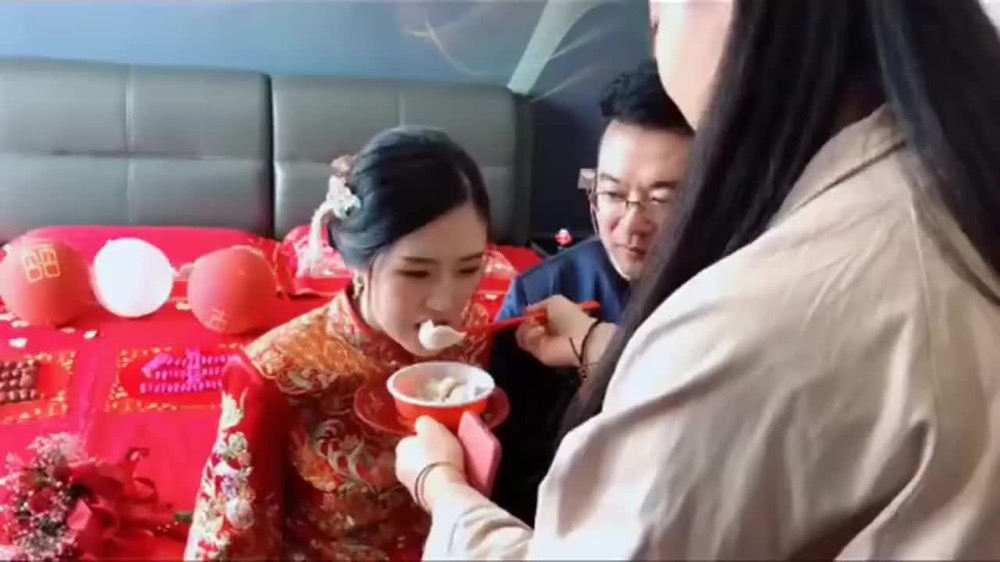
dumplings in Chinese birthday
Eating dumplings on birthdays carries the following symbolism:
Symbol of wealth and joy: Eating dumplings on birthdays signifies the transition from the old to the new year, welcoming wealth and treasures, abundant financial resources, and bringing joy and laughter to the whole family.
Symbolic resemblance to ancient currency: The shape of dumplings resembles ancient Chinese coins, such as yuanbao, which symbolize wealth and prosperity. Therefore, eating dumplings on birthdays is believed to bring good fortune and attract wealth.
Symbolism of rolling prosperity: When cooking dumplings, it is customary to add three batches of cold water to the pot and let the dumplings roll three times. This ritual signifies the rolling of prosperity in the new year, symbolizing abundant financial resources and blessings.
The Customs of Dumplings
Chinese New Year (Spring Festival):
Dumplings are a staple food and local snack in northern China, as well as a traditional food during the Chinese New Year. The custom of eating dumplings during the holiday mainly exists in the northern region. Since the word “dumpling” sounds similar to “exchange” in Chinese, it symbolizes the exchange of years, making it a popular tradition among the people in northern China. Dumplings have become an essential delicacy during the Chinese New Year. In many Han Chinese regions, eating dumplings on New Year’s Eve, while staying up late, is a grand feast that cannot be replaced by any other delicacies. There is a folk saying that goes, “Nothing tastes better than dumplings.”
Winter Solstice:
Every year, on the Winter Solstice, people in northern China cook a pot of steaming hot dumplings. Dumplings symbolize dispelling the cold, and there is a saying that goes, “If you don’t hold a dumpling bowl on the Winter Solstice, your ears will freeze and no one will care.” Regardless of wealth or poverty, dumplings are an indispensable festive dish on this day. There is a saying, “On October 1, the Winter Solstice arrives, and every household eats dumplings.”
First Week after the Summer Solstice:
There is a saying, “Dumplings in the first week after the summer solstice, noodles in the second week.” During the hot weather of the summer solstice, people easily feel tired and lose their appetite. After enduring such hardships, it’s necessary to treat oneself with something good, and dumplings are the perfect choice to stimulate the appetite.
Fifth Day of the Lunar New Year:
The fifth day of the Lunar New Year is known as “Pōwǔ Jié” or “Breaking Five Festival.” The main custom on this day is to eat dumplings, known as “Pōwǔ Jiǎozi,” with the intention of “pinching the mouths of troublemakers.” This signifies the wish for smooth sailing in the new year.
Start of Winter:
In northern China, there is a saying, “If you don’t hold a dumpling bowl on the Start of Winter, your ears will freeze and no one will care.” Eating dumplings on the Start of Winter is an important tradition that has been passed down through the generations. Throughout the entire winter season, whether it’s during festivals or daily meals, dumplings are a fixed part of the menu. Nowadays, in the eyes of the people in northern China, dumplings are beloved regardless of season transitions, bidding farewell to the old and welcoming the new, adhering to customs, or seeking warmth. During festivals and holidays, there are few foods that surpass dumplings in popularity. From the Start of Winter onward, people eat dumplings on the Start of Winter, Winter Solstice, and during the Chinese New Year, including the Little New Year, New Year’s Eve, and the fifth day of the Lunar New Year. Although there are various ways to celebrate different festivals and seasonal transitions, people always reach a consensus when it comes to eating dumplings.
Other Festivals:
There is a folk saying in northern China, “Nothing tastes better than dumplings.” In the northern region, dumplings are a must-eat food for any celebration or festival. Whether it’s New Year’s Day, the 23rd day of the twelfth lunar month (Little New Year), New Year’s Eve, the second day of the first lunar month (Sending Off the Year), or the first day of the sixth lunar month (Half-Year Festival), dumplings are always included. Other significant holidays also include a dumpling meal.
Coins in Dumplings
During the Chinese New Year, making dumplings by hand is an essential part of the festive cuisine. As one of the most popular dishes, dumplings hold an irreplaceable position in people’s hearts. During the New Year, families come together to participate in various steps of making dumplings, such as preparing the filling, rolling the dough, wrapping the dumplings, and cooking them. There is also a tradition of putting a coin inside one or several dumplings.
Why do we put coins in dumplings during the Chinese New Year? It symbolizes good luck and auspicious beginnings. This practice is prevalent in most northern regions of China. During the process of making dumplings, placing a coin inside signifies that the person who finds the coin in their dumpling will have good fortune and financial success in the new year. It is believed to originate from an ancient farming civilization, where laborers expressed their hopeful wishes for wealth in the coming year. Dumplings themselves already symbolize wealth and prosperity. As the transition between two years, eating dumplings represents the exchange of the old and the new. Additionally, the shape of the dumplings resembles ancient Chinese currency, yuanbao, so consuming them implies the acquisition of wealth in the coming year. By adding a coin to the dumpling and having someone find it, it signifies their potential to prosper and be blessed in the upcoming year. Chinese people pay great attention to good omens, from copper coins to modern-day coins, and this small custom has always been popular among the masses.
Adding to the festive atmosphere, placing a coin inside the dumpling is also a novel practice that reflects Chinese traditional culture. In the Shandong province, when making dumplings for the New Year, people include three items in the dumplings: gluten symbolizing happiness, coins symbolizing wealth, and sugar symbolizing sweetness. In many other regions, coins are used. If someone eats a dumpling with a coin, it is believed that they will have abundant wealth in the new year, symbolizing a continuous stream of financial prosperity.
Different regions may have variations in the stuffing ingredients. While some places emphasize putting coins in the dumplings, other families consider hygiene issues related to coins and choose alternative items. When making dumplings, people often include items like golden wish, sugar, peanuts, dates, and chestnuts in the filling. Eating a dumpling with a golden wish symbolizes a sweeter life in the coming year, consuming a sugar-filled dumpling signifies good fortune, enjoying a peanut-filled dumpling represents health and longevity, and savoring a dumpling with dates and chestnuts implies an early and noble offspring. In some regions, families also accompany dumplings with other auspicious side dishes. For example, eating tofu symbolizes family happiness, consuming persimmons represents everything going smoothly, and enjoying a dish with three fresh vegetables symbolizes an auspicious start. In Taiwan, people eat fish balls, meatballs, and hair-like moss to symbolize family reunion and financial prosperity.
Dumpling Banquet
In Chinese folklore, it is said that “nothing is more delicious than dumplings.” Dumplings are considered a special delicacy that cannot be replaced by any other food on the dining table. There are many customs and traditions associated with eating dumplings. For example, in many regions, people will eat vegetarian dumplings on New Year’s Eve or the first day of the lunar new year, hoping for a peaceful and trouble-free year ahead. These dumplings must be prepared and cooked before midnight on New Year’s Eve. The dumplings are cooked at the moment when the old year transitions into the new year, symbolizing the arrival of a new year’s fortune. In some northern regions, people even put coins inside the dumplings, and those lucky enough to find a coin in their dumpling are believed to attract wealth throughout the new year.
The tradition of using dumplings for banquet feasts dates back over a thousand years to the Tang Dynasty. During that time, the capital city of Chang’an was the economic and cultural center of the Tang Dynasty. As the prosperity and demands for a higher quality of life grew, culinary culture also developed. In the Tang Dynasty, there was a grand feast called the “Shao Wei Banquet,” which was a sumptuous meal offered to the emperor by high-ranking officials to celebrate their promotion. A preserved menu from the Tang Dynasty called the “Shao Wei Banquet” has been discovered, and it includes a dish called “Twenty-Four Solar Terms Wonton.” This dish featured dumplings shaped and filled according to the twenty-four solar terms, showcasing a variety of shapes and flavors.
The Dumpling Banquet originated in Xi’an, where it initially consisted of 108 different types of dumplings. Over time, the number of dumplings included in the banquet has far exceeded the number 108. To cater to different guests’ preferences, the Xi’an Dumpling Banquet is divided into several categories, such as the Welcome Banquet, Imperial Banquet, Auspicious Banquet, and Dragon-Phoenix Banquet. As the name suggests, the banquet mainly features dumplings, but these dumplings have undergone significant changes in appearance, color, and taste. From the selection of ingredients, cooking techniques, arrangement, and dining methods, various new elements have been added to enhance the dining experience. Dumplings are known for their thin skin, tender filling, delightful taste, unique shapes, and endless variety.
At first glance, these dumplings resemble works of art. Especially the ones shaped like cute little animals, making it hard to decide whether to admire them or eat them. The shapes of these dumplings are often related to the filling inside. For example, dumplings filled with celery have a jade-like appearance, while steamed dumplings filled with peanuts have a nutty flavor. The colored dough used in the Dumpling Banquet is made by adding vegetable juices, such as spinach or carrot, to the regular dough. This not only enhances the visual appeal but also adds nutritional value to the dumplings. Dumplings have become a symbol of Chinese culture and tradition, representing the warm welcome extended by the ancient city of Xi’an to guests from afar.
how to make Chinese dumplings?
To make Chinese dumplings, also known as Jiaozi, you will need the following ingredients:
Ingredients:
Dumpling wrappers (can be store-bought or homemade)
Filling of your choice (common options include ground meat, vegetables, and seasonings)
Water for sealing the dumplings
Dipping sauce (optional)
Here’s a step-by-step guide on how to make Chinese dumplings:
Prepare the filling:
In a bowl, mix your desired filling ingredients together. Common fillings include ground pork, cabbage, garlic, ginger, scallions, and soy sauce. You can customize the filling according to your taste preferences.
Thoroughly combine the ingredients until well mixed.
Assemble the dumplings:
Take a dumpling wrapper and place a spoonful of filling in the center.
Moisten the edges of the wrapper with water.
Fold the wrapper in half, enclosing the filling.
Press the edges together to seal the dumpling. You can crimp the edges or use a fork to create a decorative pattern.
Cook the dumplings:
Bring a pot of water to a boil.
Carefully add the dumplings to the boiling water.
Stir gently to prevent sticking.
Cook the dumplings for about 6-8 minutes or until they float to the surface and the filling is cooked through.
Remove the dumplings from the pot using a slotted spoon and transfer them to a serving plate.
Serve:
Serve the dumplings hot with a dipping sauce of your choice. Common options include soy sauce, vinegar, sesame oil, and chili oil.
Enjoy the dumplings while they are still warm and flavorful.
how to make Chinese dumplings dough?
Dough preparation: The most common flour used is wheat flour, but some places use buckwheat flour. Use cold water to knead the dough. After kneading the dough in a bowl, let it rest for 20 minutes to allow the dough to “relax” (allowing the water to fully penetrate the flour particles). If there is too much water, the dough will be soft and easy to wrap, but it may break easily when cooked. Conversely, if there is too little water, the dough will be hard, and rolling out the dough and wrapping it will be difficult. For a good texture, the dough should be slightly harder, as there is a saying that the dumpling should have a soft filling and a firm skin.
Wrapper preparation:
【Rolling out】: Place the rested dough on a cutting board and roll it into a cylindrical shape with a diameter of 2-3 centimeters. Cut the cylinder into small pieces, each about 1.5 centimeters long, which will become the dumplings. Flatten each dumpling with your hands. Then, use a rolling pin to roll out the dumpling wrappers, making them approximately 4-7 centimeters in diameter, 0.5-1 millimeter thick, and slightly thicker in the center. When rolling out the wrappers, sprinkle some dry flour on the cutting board to prevent sticking. Nowadays, many handmade noodle shops sell pre-made dumpling wrappers using machines. When using machine-made wrappers, you may need to moisten the edges with water to seal them.
【Pleating】: Rolling out the dumpling wrappers seems to be part of urban culture. In rural areas, manual pleating methods are more commonly used. To pleat, first shape the dumpling into a flat round shape, and then use your fingers to pinch and press the edges while rotating the dumpling. The pleated wrapper will have a bowl-like shape (compared to the flat shape achieved by rolling), with less dry flour, making it easier to wrap. The downside is that pleating the wrappers takes more time compared to rolling.
how to make Chinese dumplings filling?
Chinese dumpling fillings can vary depending on personal preferences and regional cuisines. Here is a basic recipe for a traditional pork and vegetable filling:
Ingredients:
250 grams ground pork
100 grams cabbage, finely chopped
50 grams Chinese chives or green onions, finely chopped
50 grams shiitake mushrooms, soaked and finely chopped
2 cloves garlic, minced
1 teaspoon ginger, minced
1 tablespoon soy sauce
1 tablespoon oyster sauce
1 teaspoon sesame oil
1/2 teaspoon salt
1/4 teaspoon ground black pepper
Instructions:
In a large mixing bowl, combine the ground pork, cabbage, Chinese chives or green onions, shiitake mushrooms, minced garlic, and minced ginger.
Add the soy sauce, oyster sauce, sesame oil, salt, and ground black pepper to the bowl.
Mix all the ingredients together thoroughly until well combined. You can use your hands or a spoon to mix.
Let the filling mixture sit for about 15-30 minutes to allow the flavors to meld.
Once the filling is ready, it can be used to fill the dumpling wrappers.
how to fold Chinese dumplings?
There are various ways to fold Chinese dumplings, and the technique may vary depending on the region and personal preference. Here’s a commonly used method called the “pleated crescent” fold:
- Place a dumpling wrapper on your palm or a flat surface. Use your finger or a brush to moisten the edges of the wrapper with water. This will help seal the dumpling.
- Add a small spoonful of filling (about 1-2 teaspoons) to the center of the wrapper. Be careful not to overfill, as it may make folding difficult.
- Fold the wrapper in half over the filling, creating a half-moon shape. Press the edges together to seal the dumpling.
- Starting from one end, use your thumb and index finger to pinch and fold the wrapper along the sealed edge. Create a small pleat on one side and press it firmly against the opposite side, sealing the pleat. Continue making pleats along the edge, working your way around the dumpling until it is fully sealed. Aim for around 5-6 pleats on each side, but the exact number can vary.
- Repeat the process with the remaining wrappers and filling until all the dumplings are folded.
how to cook Chinese dumplings?
Chinese dumplings can be cooked using various methods, including boiling, steaming, and pan-frying. Here’s a guide on how to cook Chinese dumplings using each of these methods:
Boiling:
- Bring a large pot of water to a boil.
- Carefully add the dumplings to the boiling water, ensuring they are not overcrowded. Stir gently to prevent sticking.
- Once the water returns to a boil, add 1/2 cup of cold water to the pot. Repeat this step two more times.
- Allow the dumplings to boil for a few more minutes until they float to the surface and the filling is cooked through.
- Use a slotted spoon to carefully remove the dumplings from the pot and drain any excess water.
- Serve the boiled dumplings with dipping sauce.
Steaming:
- Line a steamer basket or bamboo steamer with parchment paper or cabbage leaves to prevent sticking.
- Place the dumplings in the steamer, leaving some space between them to allow for expansion.
- Fill a pot or wok with water and bring it to a boil.
- Place the steamer basket or bamboo steamer on top of the pot or wok, ensuring the water does not touch the dumplings.
- Cover the steamer and steam the dumplings for about 10-15 minutes, or until the filling is cooked through.
- Carefully remove the steamer from the pot or wok.
- Serve the steamed dumplings with dipping sauce.
Pan-Frying (Potstickers):
- Heat a non-stick frying pan or skillet over medium heat and add some oil.
- Place the dumplings in the pan, leaving some space between them.
- Cook the dumplings for a couple of minutes until the bottoms turn golden brown.
- Pour water into the pan, enough to cover about 1/3 of the height of the dumplings.
- Quickly cover the pan with a lid to trap the steam and reduce splattering.
- Cook the dumplings for about 8-10 minutes, or until the water has evaporated and the bottoms are crispy.
Carefully remove the dumplings from the pan and serve them with dipping sauce.
Remember to adjust the cooking time depending on the size and thickness of the dumplings. Also, feel free to experiment with different cooking methods to find your favorite way of preparing Chinese dumplings. Enjoy your delicious homemade dumplings!
how to eat Chinese dumplings?
Eating Chinese dumplings is a delightful experience, and there are a few steps to follow to fully enjoy them. Here’s a guide on how to eat Chinese dumplings:
Dipping Sauce:
- Prepare a dipping sauce to enhance the flavors of the dumplings. Popular options include a combination of soy sauce, vinegar, sesame oil, minced garlic, and chili oil. Adjust the proportions to suit your taste preferences.
Serving:
- Place the cooked dumplings on a serving plate or bamboo steamer, allowing them to cool slightly.
Chopsticks:
- Chinese dumplings are traditionally eaten using chopsticks. Hold a pair of chopsticks in your dominant hand and use the other hand to hold a small dish or bowl for the dipping sauce.
Dipping:
- Use the chopsticks to pick up a dumpling from the serving plate, being careful not to tear the wrapper.
- Dip the dumpling into the sauce, coating it evenly. You can dip just the filling or the entire dumpling, depending on your preference.
Bite-size:
- Place the dumpling on a spoon or hold it with the chopsticks close to your mouth.
- Take small, careful bites to avoid burning your mouth. Chinese dumplings are typically filled with juicy ingredients, so be cautious of the hot filling.
Enjoy:
- Savor the flavors and textures of the dumpling. Appreciate the combination of the soft wrapper and the delicious filling.
Repeat:
- Continue enjoying the dumplings, trying different flavors and variations.
- Remember, eating dumplings can be a social and interactive experience. Enjoy the meal with friends and family, sharing stories and laughter as you savor each dumpling.
why do dumplings float when cooked?
When dumplings are cooked, they undergo a physical change that causes them to float in the cooking liquid. This phenomenon is primarily due to the way the ingredients and cooking process interact. Here are the main reasons why dumplings float when cooked:
Trapped Air: When dumplings are filled and sealed, small air pockets or bubbles may be trapped inside the filling or between the filling and the wrapper. As the dumplings cook, the heat causes the trapped air to expand, making the dumplings less dense and buoyant. This buoyancy causes them to rise and float in the cooking liquid.
Steam Generation: As the dumplings cook, the heat applied to the cooking liquid creates steam. The steam is generated within the dumplings due to the heat, causing them to become lighter and less dense. This change in density contributes to the dumplings floating in the liquid.
Starch Gelatinization: Dumpling wrappers are typically made from wheat or rice flour, both of which contain starch. During cooking, the starch in the wrapper absorbs water and undergoes gelatinization, a process in which the starch granules swell and absorb moisture. This gelatinization makes the wrapper more porous and less dense, contributing to the dumplings’ ability to float.
Cooking Time: Dumplings are typically cooked in boiling water or steamed, and the cooking process usually takes a few minutes. During this time, the heat gradually penetrates the dumplings, causing the ingredients to cook and expand. As the filling cooks and expands, it further contributes to the dumplings’ buoyancy, allowing them to float.
It’s important to note that not all dumplings float immediately upon cooking. Dumplings may sink initially and then rise to the surface as they cook further. The floating of dumplings is a natural occurrence and indicates that they are cooked and ready to be enjoyed.
why do dumplings fall apart?
Dumplings may fall apart for several reasons, and addressing these factors can help you prevent the issue. Here are some common reasons why dumplings might fall apart and some tips to avoid it:
Insufficient Binding: If the dumpling filling lacks proper binding ingredients, such as egg, cornstarch, or a starchy ingredient like mashed potato, the filling may not hold together well. Make sure to include binding agents in your filling recipe to provide cohesion.
Overfilling: Overfilling the dumplings with too much filling can cause them to burst or fall apart during cooking. Use an appropriate amount of filling for each dumpling, leaving enough room to seal the edges without straining them.
Poor Sealing: Properly sealing the dumplings is crucial to prevent the filling from leaking out and the dumplings from falling apart. Ensure that the edges of the wrapper are tightly sealed and free from any gaps or openings. Use water or egg wash to moisten the edges for better adhesion.
Dry Wrappers: If the dumpling wrappers become too dry or have been stored improperly, they can become brittle and prone to cracking or breaking. Keep the wrappers covered with a damp cloth while working with them, or follow the storage instructions provided on the packaging.
Insufficient Cooking Time: If the dumplings are not cooked for a sufficient amount of time, the dough may not fully cook and may remain undercooked or doughy, causing the dumplings to fall apart. Make sure to cook the dumplings according to the recommended cooking time in the recipe or until the wrappers are fully cooked and tender.
Rough Handling: Rough handling of the dumplings while cooking or transferring them from the cooking vessel to a plate can cause them to break apart. Use a gentle touch when handling the dumplings to avoid any unnecessary pressure or force that may cause them to fall apart.
By paying attention to these factors and following proper techniques, you can help prevent your dumplings from falling apart and ensure they hold together during the cooking process.
types of dumplings around the world
【Russian Dumplings】: Russian dumplings, known as “pelmeni,” are typically filled with beef, carrots, eggs, onions, salt, and monosodium glutamate. They often include a touch of chili pepper in the filling, and they are larger in size compared to Chinese dumplings. Russian dumplings are traditionally cooked in a clear broth made from beef bones. In Russian cuisine, drinking the dumpling broth is considered the first course, while eating the dumplings is the second course.
【British Dumplings】: In the UK, “dumpling” refers to a different traditional English food. It involves simmering a mixture of beef, carrots, tomatoes, onions, and potatoes in a rich broth. The dumplings are made by combining suet (beef fat) and flour, forming a dough that is then simmered in the stew until cooked. There is also a similar dish called “Cornish pasties” in Britain, which has a filling of potatoes and beef.
【Indian Dumplings】: Indian dumplings are similar to Russian dumplings in terms of ingredients and preparation. However, they are larger in size. Instead of boiling, they are either baked or deep-fried. The filling typically consists of potatoes, peas, and other vegetarian ingredients.
【Mexican Dumplings】: Mexican dumplings, known as “tamales,” are made with a filling of onions, beef, tomatoes, and celery. The dough is not rolled out but pressed by hand into rectangular shapes. The dumplings are not boiled in plain water but cooked in a seasoned broth made with tomatoes, chili peppers, and onions. After eating the dumplings, the soup is consumed as well, following the concept of “drinking the soup that cooked the food.”
【Italian Dumplings】: Italian dumplings, known as “gnocchi,” have a significantly different filling compared to Chinese dumplings. The main ingredients include cheese, onions, and egg yolks, sometimes supplemented with spinach or beef. Another variation uses chicken and cheese as the main ingredients, with butter, onions, lemon zest, and nutmeg as the primary seasonings. Italian dumplings are made by rolling the dough into long ropes, then cutting them into individual pieces. The edges are moistened with water, and another piece of dough is pressed on top to seal them. The cooking method for Italian dumplings is similar to that of Chinese dumplings.
【Hungarian Dumplings】: Hungarian dumplings have a filling that is more like jam or fruit preserves. They can be made with plums, apricots, or sour cherries. The dough used to wrap the dumplings includes mashed potatoes, along with plenty of lard, eggs, sugar, and salt. The dumplings are often coated with fried breadcrumbs.
【Kazakh Dumplings】: Kazakh dumplings are a type of steamed dumpling made in medium-sized pots. The filling usually consists of lamb or beef, seasoned with spices and black pepper. Once steamed, the dumplings are typically served with a drizzle of butter, sour cream, or onion sauce.
how many calories in Chinese steamed dumplings?
The number of calories in Chinese steamed dumplings can vary depending on the specific ingredients used and the size of the dumplings. However, as a general guideline, a typical serving of four to five medium-sized steamed dumplings (approximately 100 grams) contains approximately 200-250 calories. This estimate includes both the dumpling wrapper and the filling. Keep in mind that the calorie content may be higher if the dumplings are larger or if they have a higher fat content in the filling. Additionally, the cooking method (steaming, boiling, frying) and any accompanying sauces or dips can also contribute to the overall calorie count. It’s always a good idea to check the nutritional information or consult a specific recipe for more accurate calorie details based on the ingredients and quantities you use.
how many carbs in Chinese steamed dumplings?
The carbohydrate content in Chinese steamed dumplings can vary depending on the specific ingredients used and the size of the dumplings. However, as a general guideline, a typical serving of four to five medium-sized steamed dumplings (approximately 100 grams) contains around 30-40 grams of carbohydrates. This estimate includes both the dumpling wrapper and the filling. The carbohydrate content may vary based on the type of flour used for the wrapper and the ingredients used for the filling. It’s important to note that different recipes and variations of dumplings may have slightly different carbohydrate content, so it’s always a good idea to check the specific nutritional information or consult a recipe to get more accurate details based on the ingredients you use.
is Chinese dumplings healthy?
Chinese dumplings can be a healthy food choice when prepared with nutritious ingredients and cooked in a healthy manner. Here are some factors to consider:
Filling: The filling of Chinese dumplings can vary greatly. Healthier options include fillings with lean proteins like chicken, seafood, or tofu, along with vegetables and herbs. These provide essential nutrients and can be lower in calories and saturated fat compared to fillings with fatty meats.
Steaming: Steamed dumplings are a healthier cooking method compared to frying. Steaming helps retain more nutrients and reduces the amount of added fat in the dish.
Portion Size: The portion size of dumplings is important. Moderation is key to avoid overeating. Controlling the portion size and enjoying dumplings as part of a balanced meal can contribute to a healthy diet.
Dipping Sauce: Be mindful of the dipping sauce you choose. Traditional soy sauce can be high in sodium, so opt for reduced-sodium soy sauce or other healthier alternatives like vinegar, chili sauce, or ginger sauce in moderation.
Balance and Variety: Including a variety of foods in your overall diet is important for a healthy lifestyle. Chinese dumplings can be enjoyed as part of a balanced meal along with other nutritious foods like vegetables, whole grains, and lean proteins.
It’s worth noting that the nutritional value and healthiness of Chinese dumplings can vary depending on the specific recipe and cooking methods used. Homemade dumplings allow for more control over the ingredients and can be a healthier option compared to store-bought or deep-fried dumplings.
are Chinese dumplings vegan?
Chinese dumplings can be made vegan by using plant-based ingredients for the filling and wrapper. Here are some common vegan options for Chinese dumplings:
Filling: Replace meat with plant-based proteins such as tofu, tempeh, seitan, or textured vegetable protein (TVP). You can also incorporate a variety of vegetables like cabbage, mushrooms, carrots, spinach, or water chestnuts for texture and flavor.
Wrapper: Traditional dumpling wrappers are typically made from wheat flour, water, and sometimes eggs. However, you can find or make vegan dumpling wrappers by using wheat flour and water without eggs. Alternatively, you can use wrappers made from rice flour or other gluten-free flours if you have dietary restrictions.
Seasoning: Use soy sauce, sesame oil, ginger, garlic, scallions, and other vegan-friendly seasonings to add flavor to the dumpling filling. Be cautious with pre-made sauces, as some may contain animal-derived ingredients. Check the ingredient labels or make your own vegan dipping sauce using soy sauce, vinegar, chili oil, and other preferred seasonings.
Cooking Method: Steaming or boiling dumplings is a vegan-friendly cooking method. Avoid frying the dumplings in oil, as it adds unnecessary calories and fat.
It’s important to note that while many Chinese dumplings can be made vegan, not all dumplings you encounter will be vegan by default. Some traditional recipes may use animal-based ingredients or egg in the wrappers. If you’re dining out or purchasing dumplings, it’s always best to check with the cook or read the ingredient labels to ensure the dumplings are vegan-friendly.
are Chinese dumplings keto friendly?
Traditional Chinese dumplings are not considered keto-friendly due to their high carbohydrate content from the wheat flour used in the wrappers. However, you can make keto-friendly dumplings by making some modifications to the recipe. Here are a few suggestions:
Replace the wheat flour wrapper: Instead of using wheat flour, you can make dumplings with low-carb alternatives such as almond flour, coconut flour, or a combination of both. These flours are lower in carbohydrates and higher in healthy fats.
Use a low-carb filling: Opt for a filling that is low in carbohydrates and high in healthy fats and proteins. You can use ingredients like ground meat (such as pork, chicken, or beef), seafood, tofu, and a variety of low-carb vegetables like cabbage, spinach, mushrooms, or zucchini. Be mindful of the carbohydrate content of the vegetables you choose.
Adjust seasonings: Stick to keto-friendly seasonings and sauces such as soy sauce, sesame oil, ginger, garlic, and spices. Avoid using sauces that are high in sugar or contain added carbohydrates.
Cook in a keto-friendly manner: Instead of boiling or steaming the dumplings, you can pan-fry them in a healthy fat like coconut oil or ghee. This adds a crispy texture and enhances the flavor.
Remember to consider the nutritional composition of the ingredients you use and track your intake to ensure you stay within your daily carbohydrate limit while following a keto diet. It’s also a good idea to consult with a healthcare professional or registered dietitian for personalized advice and guidance on following a keto diet.
are Chinese dumplings and potstickers the same thing?
Chinese dumplings and potstickers are similar but not exactly the same. The main difference lies in their cooking method and texture.
Chinese Dumplings (Jiaozi):
- Chinese dumplings, also known as jiaozi, are a traditional Chinese dish made with a thin dough wrapper filled with a mixture of ground meat, vegetables, and seasonings.
- They can be boiled, steamed, or pan-fried.
- Boiled dumplings have a softer texture, while steamed dumplings are softer and more moist. Pan-fried dumplings have a crispy bottom and a soft top.
- Chinese dumplings are typically served with dipping sauces such as soy sauce, vinegar, or a combination of both.
Potstickers (Guotie):
- Potstickers, also known as guotie, are a specific type of Chinese dumpling that is pan-fried.
- They are called potstickers because they are initially fried in a pan to create a crispy bottom, and then water is added to the pan to steam and cook the dumplings.
- The result is a dumpling with a crispy bottom and a slightly chewy texture on top.
- Potstickers are often served with a dipping sauce similar to Chinese dumplings.
In summary, while potstickers are a type of Chinese dumpling, the term “dumplings” can refer to a broader category of dumplings that includes boiled, steamed, and pan-fried variations. Potstickers specifically refer to a style of dumplings that are pan-fried and then steamed.
dumplings vs momos
Dumplings and momos are similar in that they are both types of filled dough pockets commonly found in different cuisines. However, there are some differences between the two:
Origin: Dumplings have a broader global presence and are found in various cuisines, including Chinese, Korean, Japanese, Polish, and Italian, among others. Momos, on the other hand, are a specific type of dumpling originating from Tibetan and Nepalese cuisine.
Dough: The dough used for dumplings can vary depending on the cuisine. It is typically made from wheat flour, but in some regions, other types of flour like rice or buckwheat may be used. Momos are typically made from wheat flour, but in some cases, all-purpose flour or a combination of flours can be used.
Filling: The filling of dumplings can vary widely based on the cuisine and regional preferences. It can include a combination of meat, seafood, vegetables, and seasonings. Momos are usually filled with a mixture of ground meat (such as lamb, chicken, or pork), along with vegetables, herbs, and spices.
Cooking Method: Dumplings can be cooked using various methods, such as boiling, steaming, pan-frying, or deep-frying, depending on the specific type and regional tradition. Momos are primarily steamed or sometimes pan-fried. They are rarely deep-fried.
Shape: Dumplings can come in various shapes, including crescent-shaped, folded, or pleated. Momos, in contrast, are typically round in shape and have a pleated closure at the top.
Serving Style: Dumplings are often served with dipping sauces or in soups, depending on the regional cuisine. Momos are commonly served with spicy tomato-based or sesame-based dipping sauces.
Overall, while both dumplings and momos share similarities as filled dough pockets, they have distinct regional origins, fillings, cooking methods, and serving styles.
dumplings vs wontons
Dumplings and wontons are both types of filled dough pockets commonly found in Asian cuisines, particularly Chinese cuisine. While there are similarities between the two, there are also some notable differences:
Wrapper: The wrapper used for dumplings is generally thicker and sturdier compared to wonton wrappers, which are thinner and more delicate.
Shape: Dumplings can come in various shapes, such as crescent-shaped, folded, or pleated. Wontons, on the other hand, are typically smaller and have a distinct triangular or folded shape.
Filling: Dumplings often have a more substantial and varied filling, which can include a combination of meat (such as pork, chicken, or shrimp), vegetables, and seasonings. Wontons traditionally have a simpler filling, commonly made with a small amount of ground meat, typically pork, along with seasonings like ginger, garlic, and green onions.
Cooking Method: Dumplings can be cooked using various methods, including boiling, steaming, pan-frying, or deep-frying. Wontons are typically boiled and served in soups. However, they can also be pan-fried or deep-fried to create crispy wontons.
Serving Style: Dumplings are often served as a main dish or as part of a meal, accompanied by dipping sauces or in soups. Wontons are primarily served in a flavorful broth, often in a soup preparation.
Regional Variations: Dumplings have various regional variations in China and are also found in other Asian cuisines. Wontons, on the other hand, have a specific regional association with Cantonese cuisine and are commonly associated with dishes like wonton soup.
While both dumplings and wontons are delicious and popular, the differences lie in their wrapper thickness, shape, filling composition, cooking methods, serving styles, and regional associations.
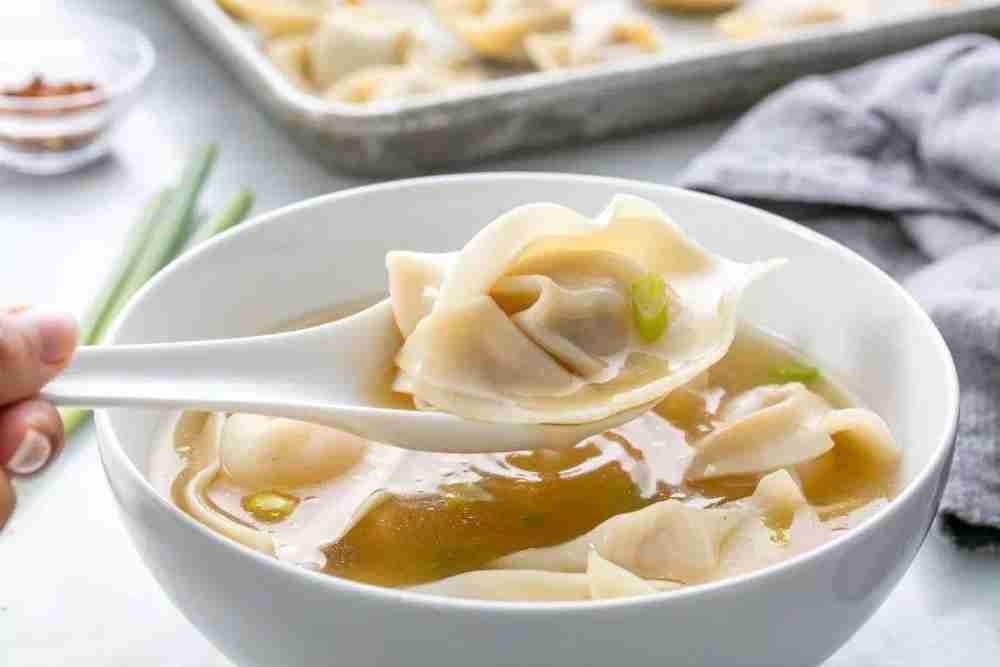
dumplings vs siomai
Dumplings and siomai (also known as shumai) are both popular types of dumplings commonly found in Asian cuisines, particularly Chinese cuisine. Here are some key differences between the two:
Wrapper: Dumplings typically have a thicker and more substantial wrapper compared to siomai. Dumpling wrappers are usually made from wheat flour, while siomai wrappers are thinner and made from a combination of wheat starch and tapioca starch.
Shape: Dumplings can come in various shapes, including crescent-shaped, folded, or pleated. Siomai, on the other hand, has a distinct open-top shape, resembling a small basket or cup.
Filling: Dumplings often have a more diverse filling that can include a combination of meat (such as pork, chicken, shrimp, or beef), vegetables, and seasonings. Siomai typically has a simpler filling, commonly made with ground pork mixed with additional ingredients like shrimp, mushrooms, and seasonings.
Cooking Method: Dumplings can be cooked through various methods, such as boiling, steaming, pan-frying, or deep-frying. Siomai is traditionally steamed, and the cooking process usually involves placing the siomai on a steamer tray or bamboo steamer.
Presentation: Dumplings are often presented individually, with their distinctive shapes and pleats visible. Siomai, on the other hand, is typically presented in a more uniform and open-top shape, with the filling exposed.
Regional Variations: Dumplings have numerous regional variations in China and are also found in other Asian cuisines. Siomai is closely associated with Cantonese cuisine and is popular in Hong Kong and other parts of southern China. It has also gained popularity in other countries with Chinese communities.
Both dumplings and siomai are delicious and widely enjoyed. The differences lie in their wrapper thickness, shape, filling composition, cooking methods, presentation, and regional associations.
dumplings vs bao
Dumplings and bao (also known as baozi or steamed buns) are both popular types of Chinese food, but they differ in several aspects:
Wrapper: Dumplings have a thin, doughy wrapper made from wheat flour, while bao has a soft and fluffy steamed bread-like exterior.
Shape: Dumplings are typically small and shaped like crescents, with the filling enclosed inside the wrapper and sealed by pleating the edges. Bao, on the other hand, are larger and have a round or oval shape, resembling a bun. They are folded in a way that creates a pocket for the filling.
Filling: Dumplings can have a wide variety of fillings, including meat (such as pork, beef, chicken, or seafood), vegetables, and seasonings. Bao also have diverse fillings, which can include meat, vegetables, or a combination of both. Some popular bao fillings include pork, char siu (barbecue pork), and vegetable fillings like mushroom and cabbage.
Cooking Method: Dumplings are typically boiled, steamed, pan-fried, or deep-fried. Bao, as the name suggests, are primarily steamed. They are placed on a steamer tray or in bamboo steamers and cooked until the dough is soft and fluffy.
Texture: Dumpling wrappers have a chewy texture, while bao has a soft and fluffy texture similar to bread.
Serving Style: Dumplings are often served in a plate or a bamboo steamer basket, while bao are usually served individually, often on small parchment papers or in bamboo steamers.
Both dumplings and bao are delicious and versatile dishes with their own unique characteristics. Dumplings are known for their thin wrappers and various shapes, while bao is famous for its soft and fluffy bread-like exterior. The fillings in both can be customized to suit different tastes and preferences.

dumplings vs buns
“Dumplings” and “buns” are broad terms used to describe different types of filled dough-based foods. Here’s how they generally differ:
Dough: Dumplings typically have a thinner and denser dough wrapper made from wheat flour. The dough is rolled out and folded around the filling, resulting in a sealed pocket. Buns, on the other hand, have a softer and fluffier dough, similar to bread dough. The dough is usually leavened and may contain additional ingredients like yeast or baking powder.
Filling: Dumplings can have a wide range of fillings, including meat, vegetables, seafood, or a combination of these. The filling is often finely chopped or minced. Buns also have various fillings, but they are typically larger and can accommodate more substantial ingredients. Common bun fillings include pork, chicken, vegetables, and even sweet fillings like red bean paste or custard.
Cooking Method: Dumplings can be cooked by boiling, steaming, pan-frying, or deep-frying. Steaming and boiling are the most common methods. Buns, on the other hand, are primarily steamed or baked. Steamed buns are cooked by placing them in a steamer, while baked buns are placed in an oven.
Shape and Appearance: Dumplings come in various shapes, such as crescent-shaped, pleated, or folded into a pouch. They are usually smaller and individually portioned. Buns, on the other hand, are typically larger and round or oval in shape. They can be filled and sealed into a ball-like shape or shaped into other forms like a bar or flower.
Texture: Dumpling wrappers are thinner and chewier, while bun dough is softer and has a more bread-like texture. Dumplings often have a slightly thicker and more substantial wrapper compared to the lighter and fluffier texture of buns.
Serving Style: Dumplings are often served as a side dish or appetizer, while buns can be a standalone meal or snack. Dumplings are commonly served in a plate or a steamer basket, while buns are typically served individually, often on small parchment papers or in bamboo steamers.
It’s important to note that the specific characteristics of dumplings and buns can vary across different cuisines and regions. The terms “dumplings” and “buns” encompass a wide range of culinary variations, so there may be further differences depending on the specific type of dumpling or bun being referred to.
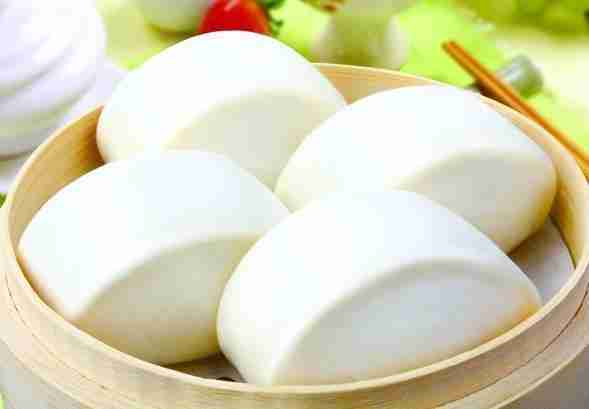
dumplings vs yuan xiao
Dumplings and Yuanxiao (also known as Tangyuan) are both types of Chinese filled dough-based foods, but they have some distinct differences:
Occasion: Dumplings are traditionally associated with the Chinese New Year and are commonly consumed as a symbol of good luck and prosperity. They are also enjoyed year-round. Yuanxiao, on the other hand, is primarily consumed during the Lantern Festival, which marks the end of the Chinese New Year celebrations.
Shape and Filling: Dumplings are typically shaped like crescents, with a thin dough wrapper folded around a filling that can include various combinations of meat, vegetables, seafood, or a mixture of these. Dumplings can be boiled, steamed, pan-fried, or deep-fried. Yuanxiao, however, are round glutinous rice balls that are usually filled with sweet fillings like sesame paste, peanut butter, or sweet bean paste. They are commonly boiled and served in a sweet broth.
Dough: Dumpling dough is made from wheat flour and water, while Yuanxiao dough is made from glutinous rice flour mixed with water. The dough for dumplings is typically rolled out and then folded or pleated around the filling. Yuanxiao dough is formed into small balls that are filled and shaped before cooking.
Cooking Method: Dumplings can be cooked by boiling, steaming, pan-frying, or deep-frying, depending on the specific type. Yuanxiao, however, are primarily boiled in water until they float to the surface, indicating that they are cooked. They are then served in a sweet broth or with a dipping sauce.
Symbolism: Dumplings are often associated with family and unity, as they are commonly made and enjoyed together during festive occasions. They symbolize togetherness and the coming together of loved ones. Yuanxiao, on the other hand, symbolize family reunion and the hope for a bright and prosperous future.
While dumplings and Yuanxiao have some similarities, such as being filled dough-based foods, their shapes, fillings, cooking methods, and cultural significance set them apart. Both are delicious and enjoyed in different contexts and occasions throughout the year in Chinese cuisine.
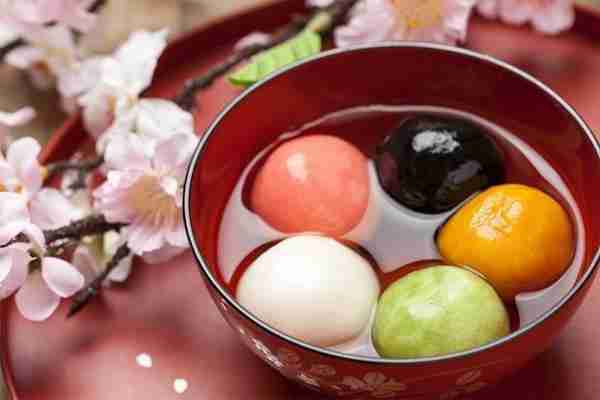
dumplings vs zongzi
Dumplings and Zongzi are both traditional Chinese foods, but they differ in several aspects:
Ingredients and Filling: Dumplings are typically made with wheat-based dough and can be filled with a variety of ingredients, including meat, vegetables, seafood, or a combination of these. The fillings can be savory or sweet, depending on the type of dumpling.
Zongzi, on the other hand, are made with sticky rice that is wrapped in bamboo leaves. The rice is usually mixed with other ingredients such as meat (commonly pork), salted egg yolk, beans, nuts, or preserved vegetables. Zongzi can have different regional variations in terms of fillings and flavors.
Shape and Wrapping: Dumplings are generally small, bite-sized parcels with a crescent or half-moon shape. The dough is wrapped around the filling and can be pleated or folded in different ways.
Zongzi, on the contrary, are pyramid-shaped or triangular packets made by wrapping sticky rice and fillings in bamboo leaves. The leaves are tied with strings to secure the shape during cooking.
Cooking Method: Dumplings are typically boiled, steamed, pan-fried, or deep-fried, depending on the type and regional preference. The cooking method varies based on the desired texture and taste.
Zongzi are traditionally boiled or steamed for an extended period, often several hours, to ensure that the sticky rice is fully cooked and infused with flavors from the fillings and bamboo leaves.
Occasion: Dumplings are commonly enjoyed throughout the year, but they hold special significance during festivals like the Chinese New Year and the Dragon Boat Festival. They are also popular as a casual meal or snack.
Zongzi, on the other hand, are specifically associated with the Dragon Boat Festival, which takes place on the fifth day of the fifth lunar month in the Chinese calendar. They are traditionally made and eaten during this festival to commemorate the poet Qu Yuan.
Both dumplings and Zongzi are beloved Chinese foods, but they have distinct shapes, fillings, cooking methods, and cultural associations. Dumplings are more versatile and commonly consumed, while Zongzi are specifically tied to the Dragon Boat Festival and have a unique preparation method using bamboo leaves and sticky rice.
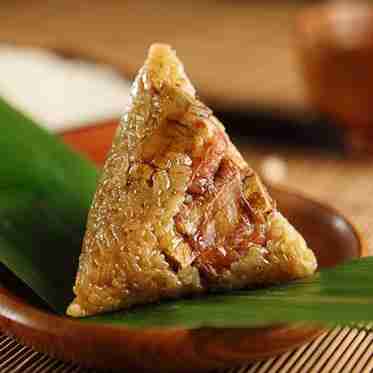
fluffy dumplings vs flat dumplings
Fluffy dumplings and flat dumplings are two different styles of dumplings with distinct characteristics:
Fluffy Dumplings: Fluffy dumplings, also known as drop dumplings or doughy dumplings, have a light and soft texture. They are typically made from a batter-like dough that is dropped directly onto the simmering broth or stew. The dough expands and puffs up during cooking, resulting in dumplings that are light, fluffy, and slightly doughy in the center.
Fluffy dumplings are often associated with comfort foods like chicken and dumplings or hearty stews. They provide a pillowy texture and absorb the flavors of the broth or sauce they are cooked in.
Flat Dumplings: Flat dumplings, also called rolled dumplings or noodle-style dumplings, have a thinner and more flat appearance compared to fluffy dumplings. The dough is rolled out into a thin sheet and then cut into rectangular or square shapes. These dumplings are typically added to simmering soups or stews and cooked until they become tender.
Flat dumplings have a more noodle-like texture and are often used in dishes like chicken and dumplings or in soups with a thinner broth. They are firmer and have a more uniform thickness throughout.
The choice between fluffy dumplings and flat dumplings depends on personal preference and the desired texture for the dish. Fluffy dumplings provide a light and doughy texture, while flat dumplings offer a more noodle-like consistency. Both types can be delicious and add unique characteristics to various dishes.
eating dumplings in dream meaning
Dreaming of dumplings indicates good luck and fortune. It is considered an auspicious sign. For those in a romantic relationship, dreaming of dumplings suggests the possibility of marriage. Individuals born in their zodiac year who dream of dumplings may experience difficulties at the beginning of the year but can expect financial gains and smoothness in the autumn. Pregnant individuals dreaming of dumplings symbolize the potential for giving birth to a girl and should be cautious about the risk of miscarriage.
Please note that dream interpretations are subjective and based on cultural beliefs. Here is the translation of the dream interpretations into English:
Dreaming of dumplings signifies good fortune and luck.
Interpretations for different individuals dreaming of dumplings:
- For individuals in a romantic relationship, dreaming of dumplings suggests the possibility of marriage.
- If you are planning to travel and dream of dumplings, it is advisable to postpone your trip for a few days.
- Individuals born in their zodiac year who dream of dumplings may face initial setbacks or losses but can expect financial gains and smoothness in the autumn.
- Students dreaming of dumplings may indicate that their exam scores are on the edge of acceptance, with less optimistic prospects.
- Pregnant individuals dreaming of dumplings suggest the possibility of giving birth to a girl and should take precautions against miscarriage.
- For businesspeople dreaming of dumplings, it indicates delayed financial gains, so patience is advised.
- Dreaming of eating dumplings with family members implies conflicts within the family, which can be resolved through peaceful communication.
- Dreaming of making dumplings suggests a happy and fulfilling life, living together with family members in joy.
- Dreaming of a table filled with dumplings indicates a period of mixed luck, with good luck coming later. Immediate success may not be achievable, but overall positive outcomes are expected.
- Dreaming of giving dumplings to others suggests potential investment opportunities but advises caution and careful consideration.
Conclusion.
Dumplings are an important traditional food in the Chinese culture, symbolizing good fortune and health. As a result, they are eaten during many of the Chinese festivities, especially in North China. As a foodie or dumpling lover, you don’t need any special occasion to enjoy this delicacy.